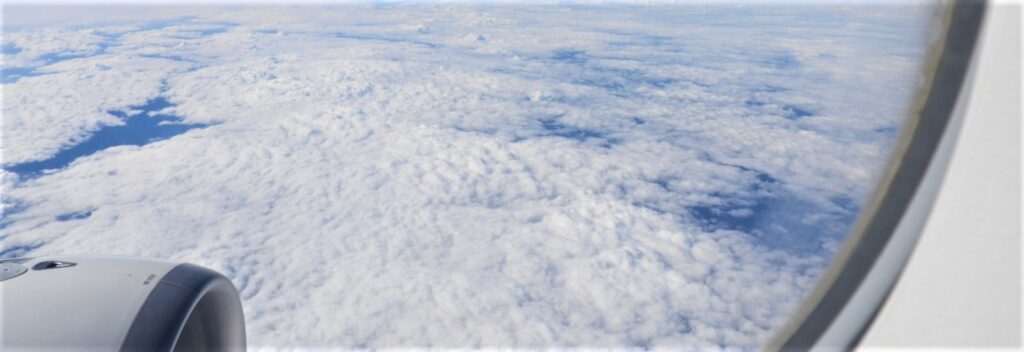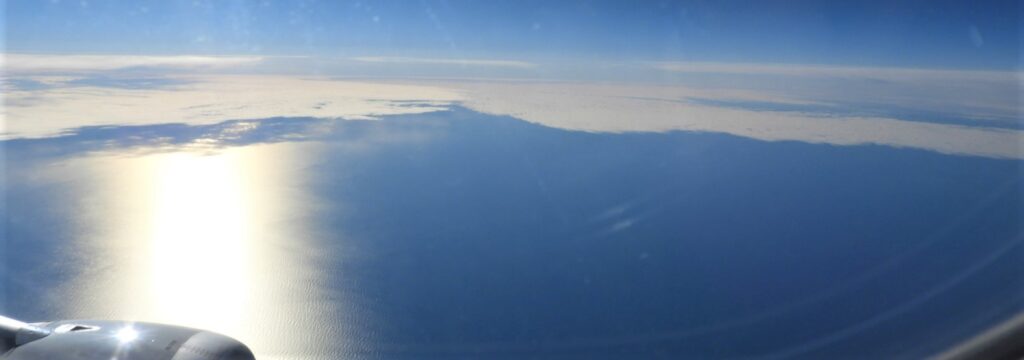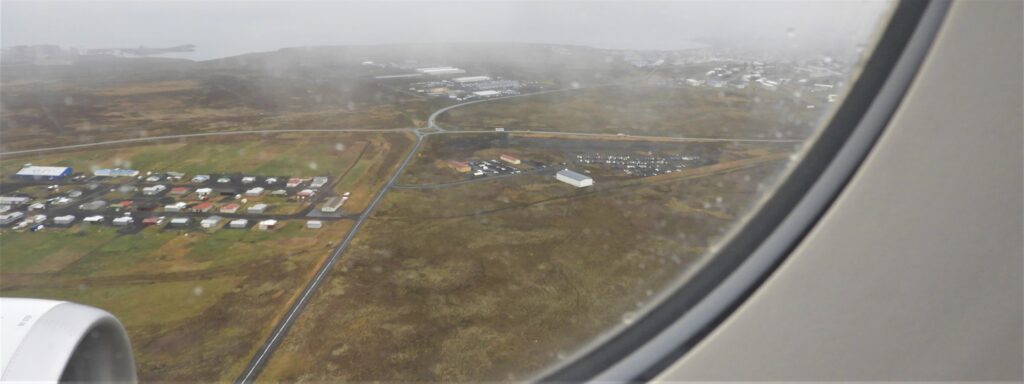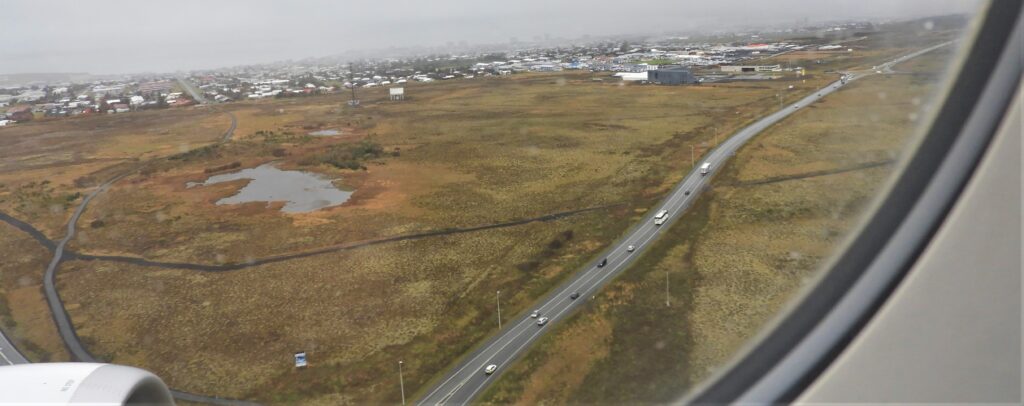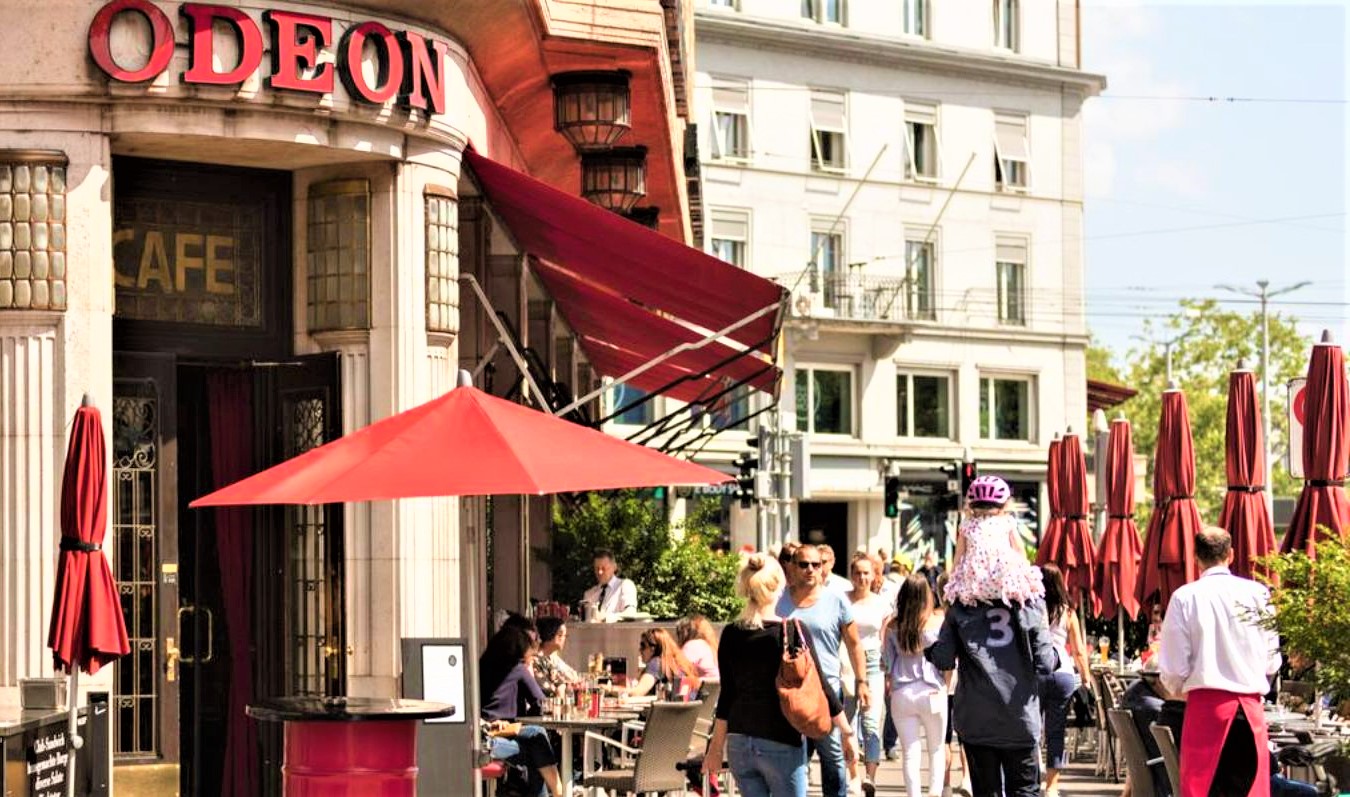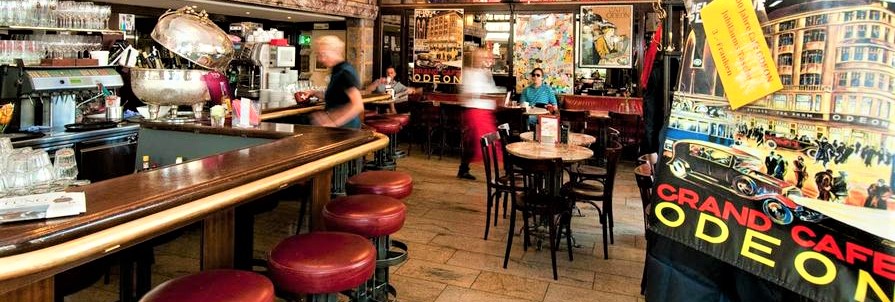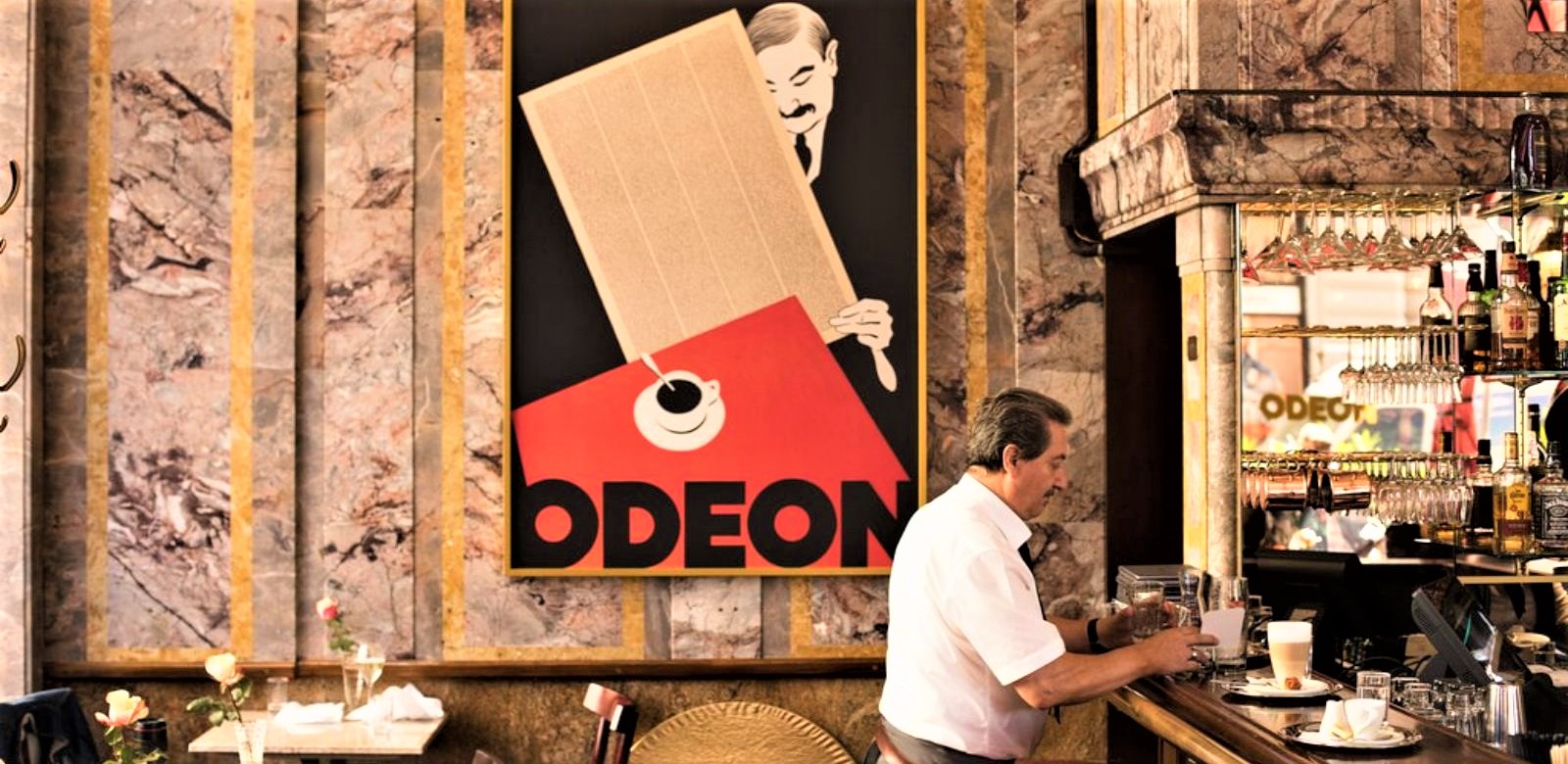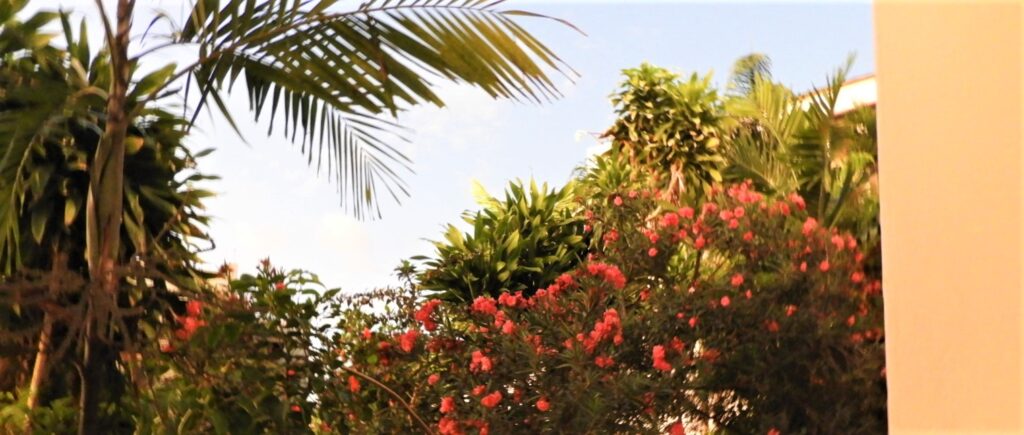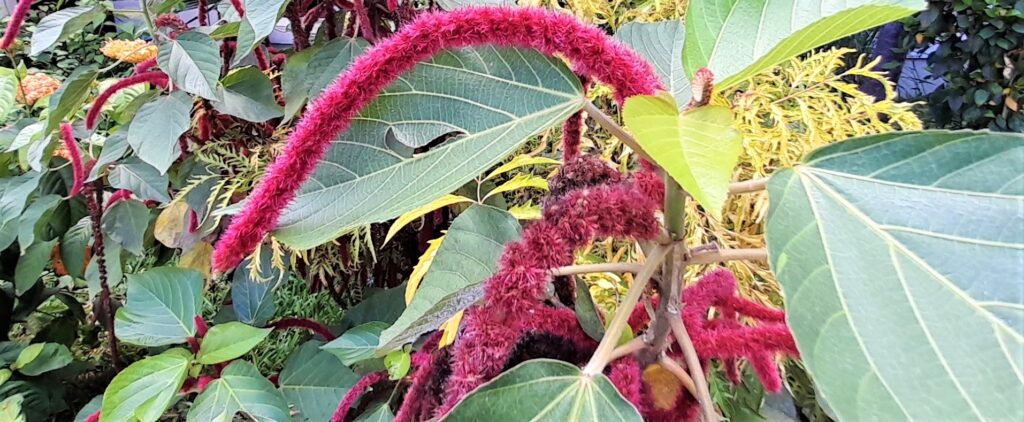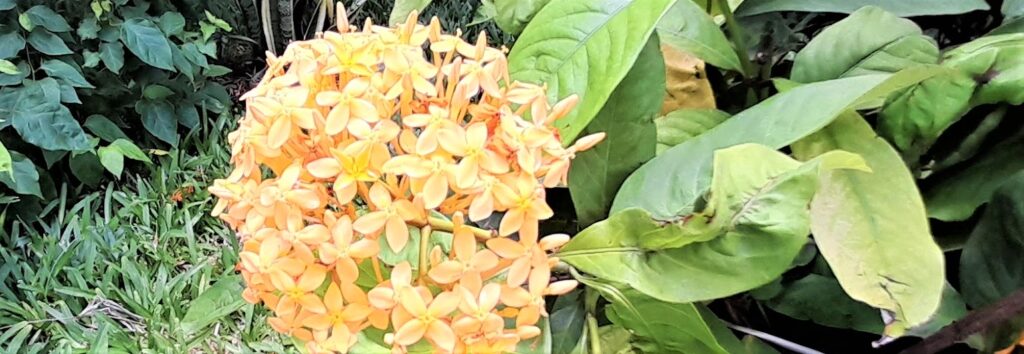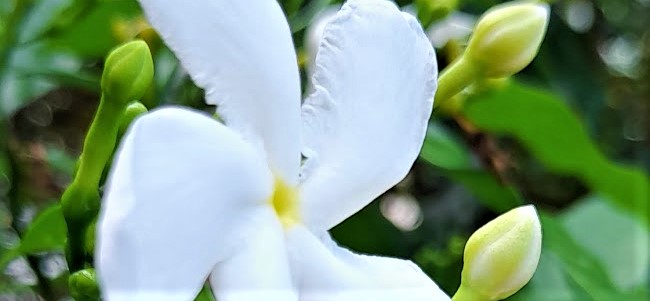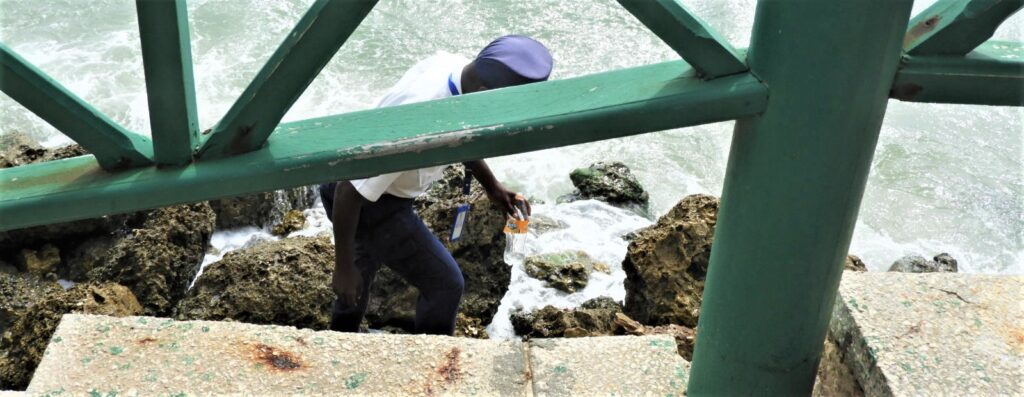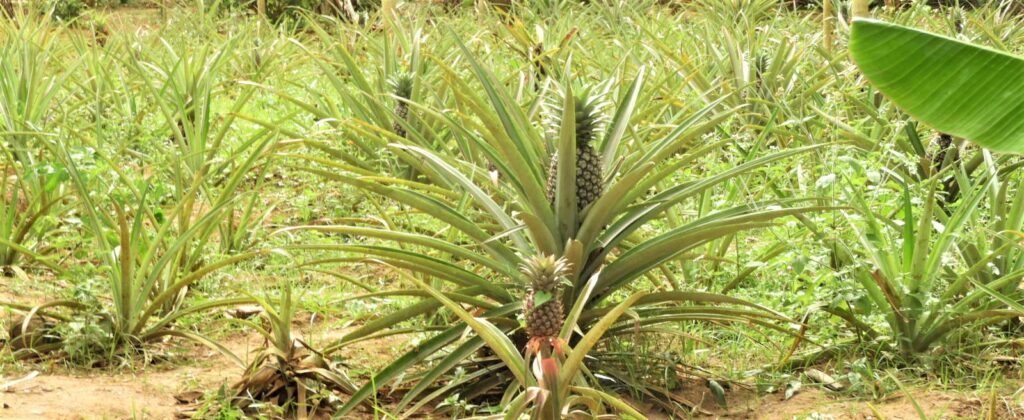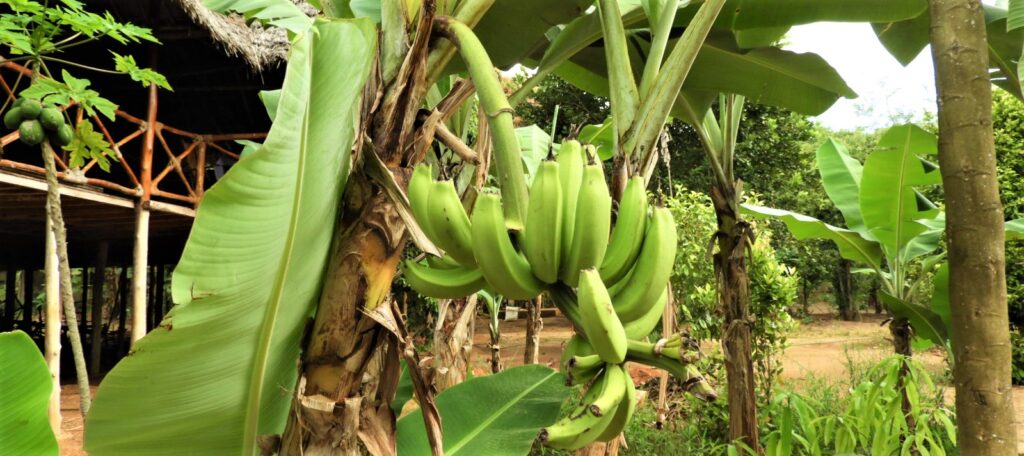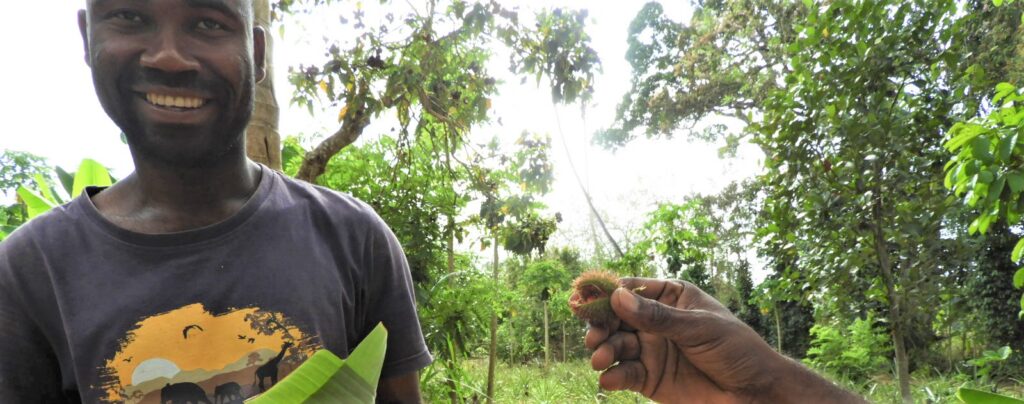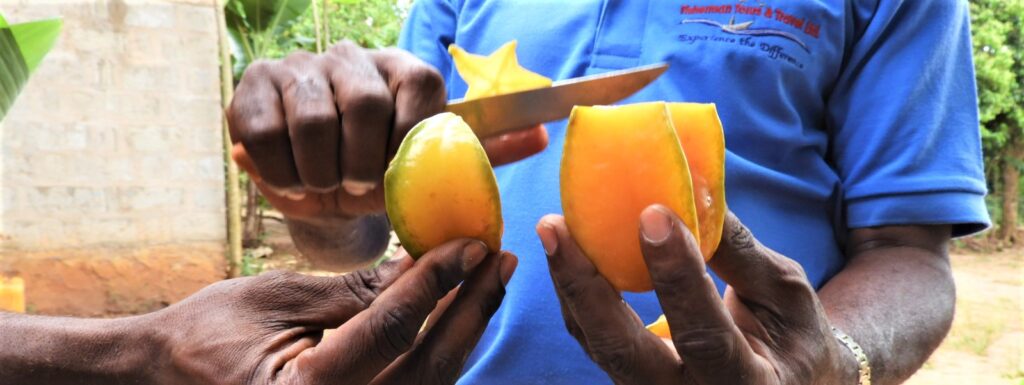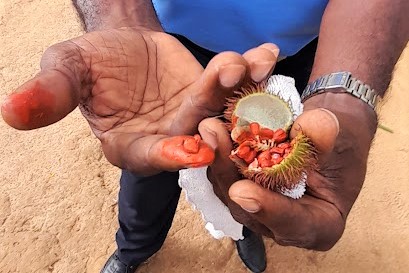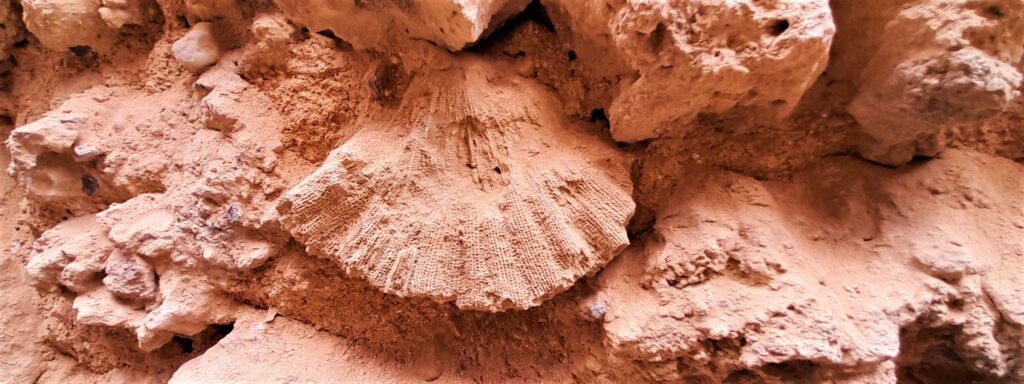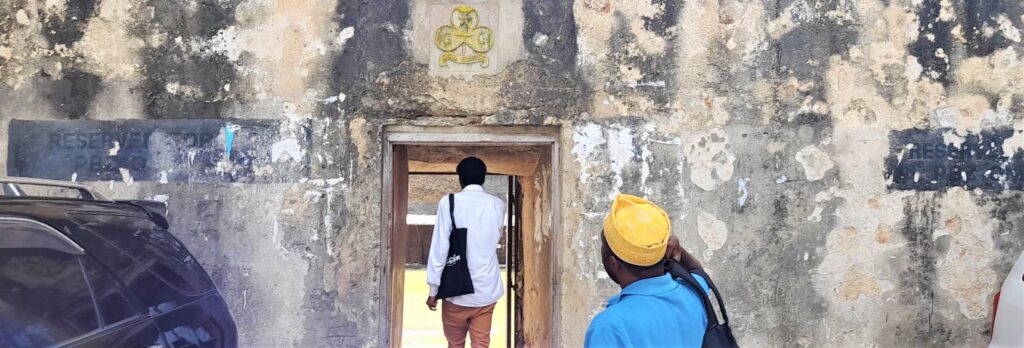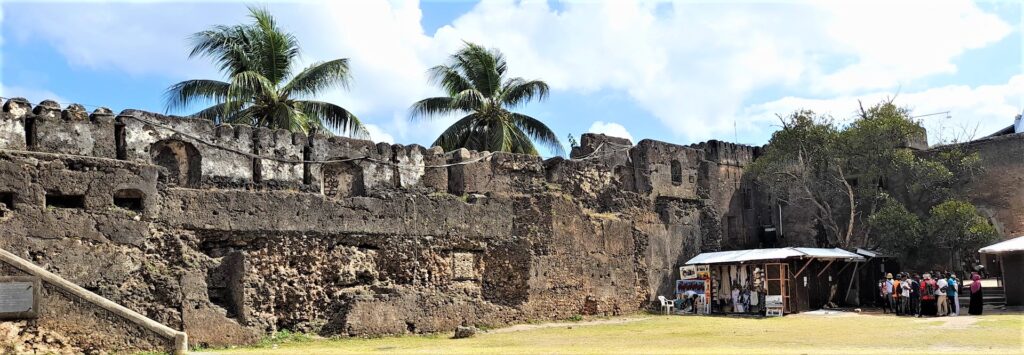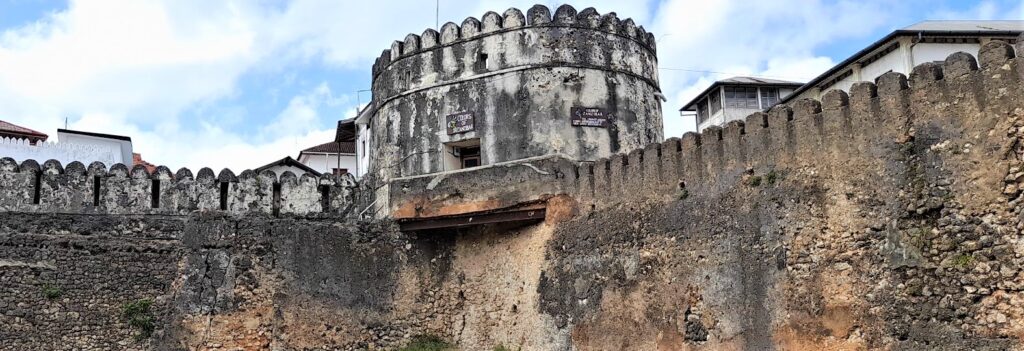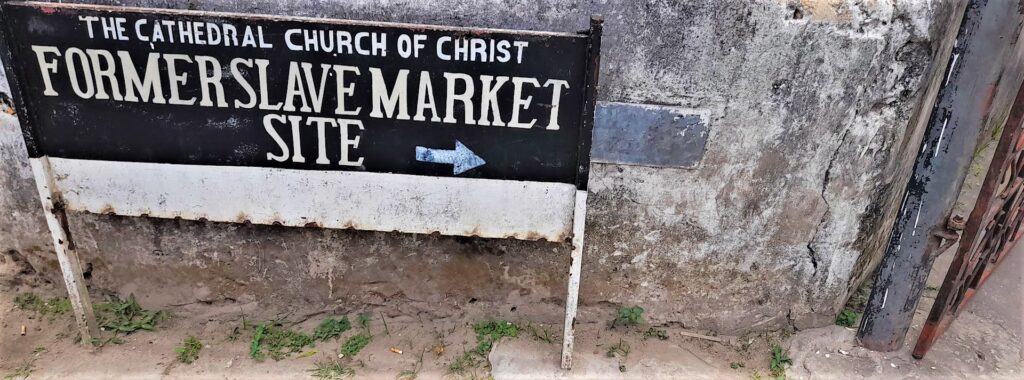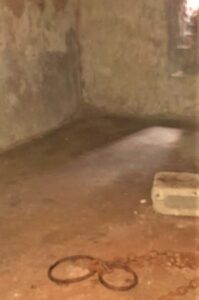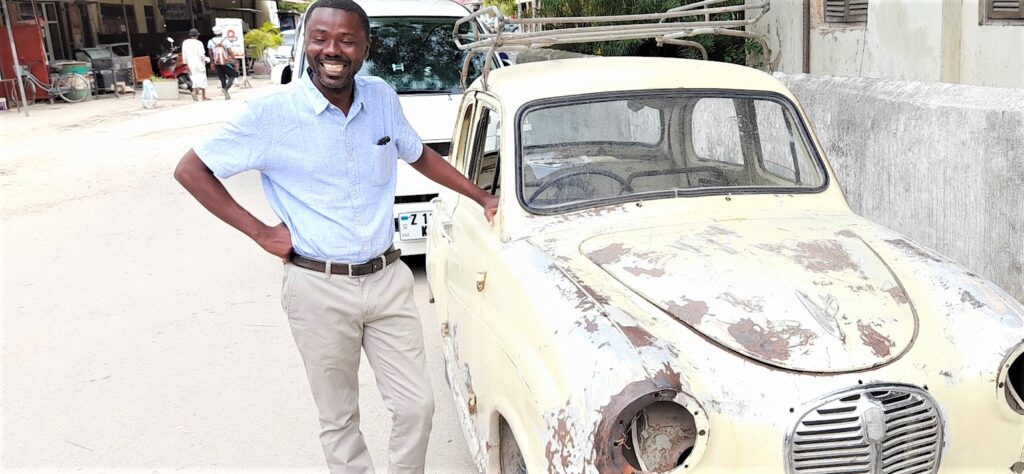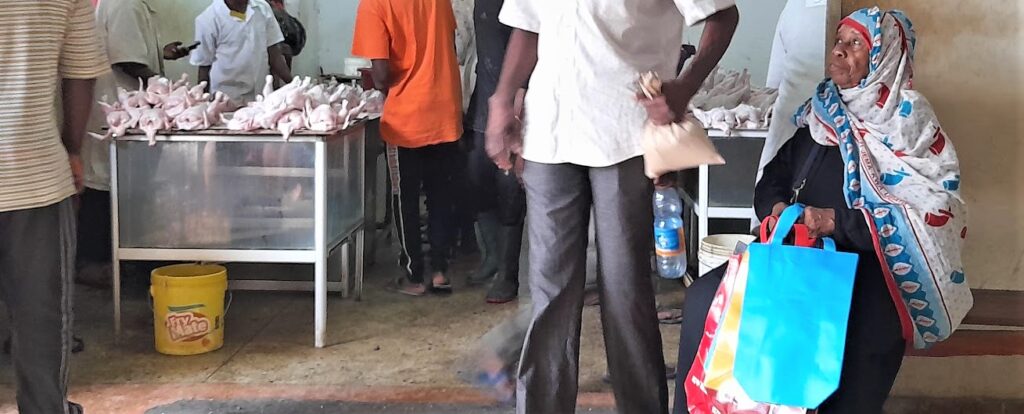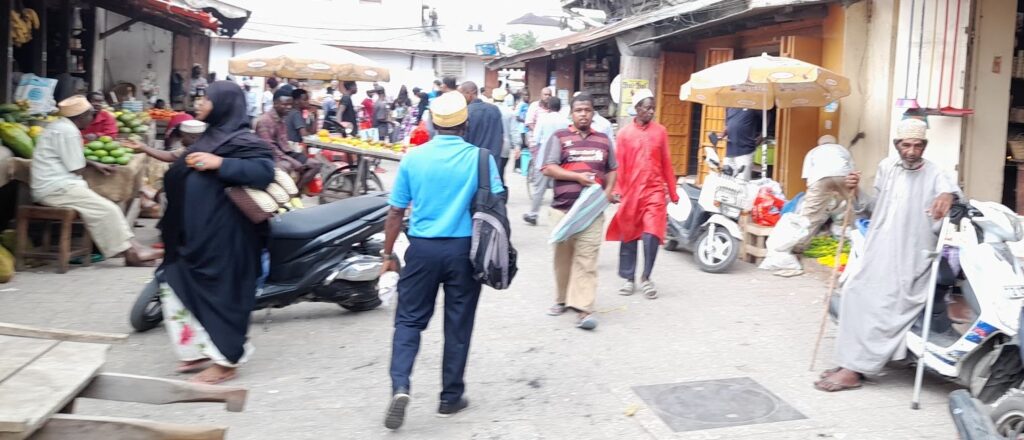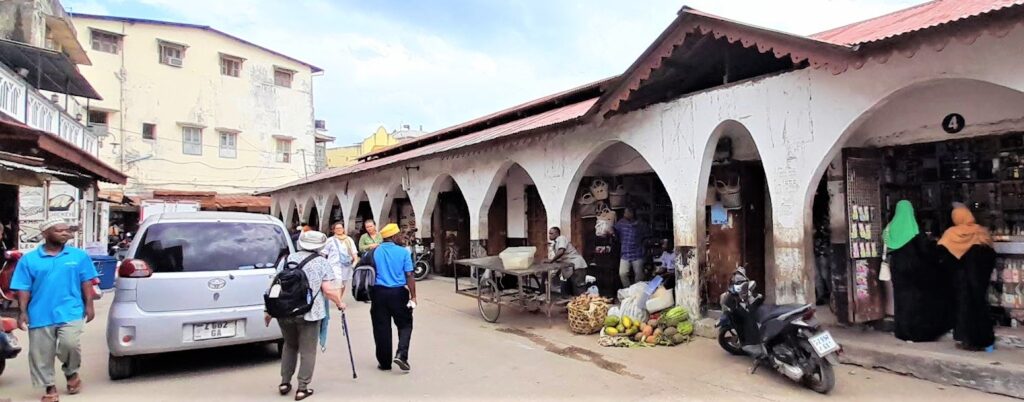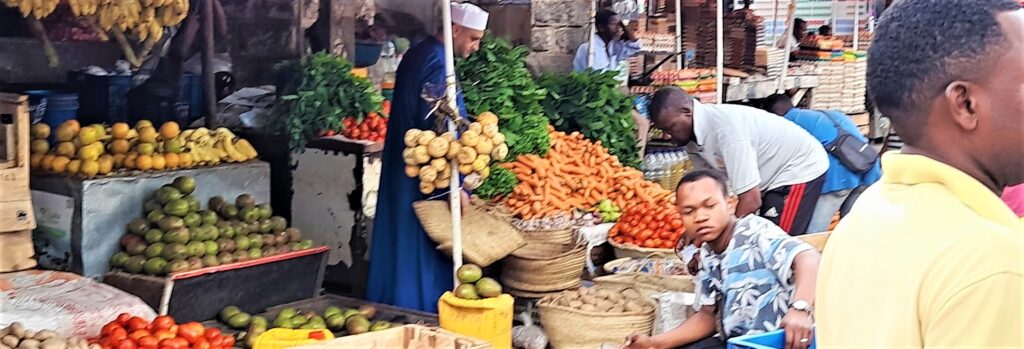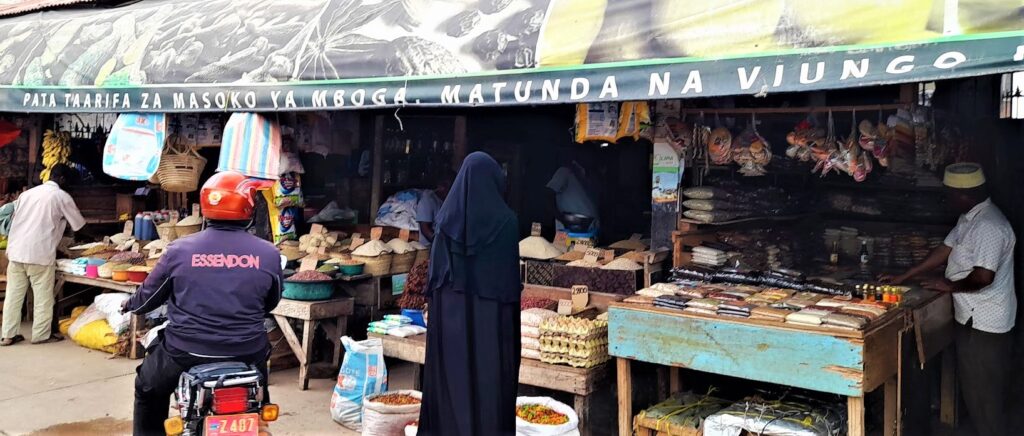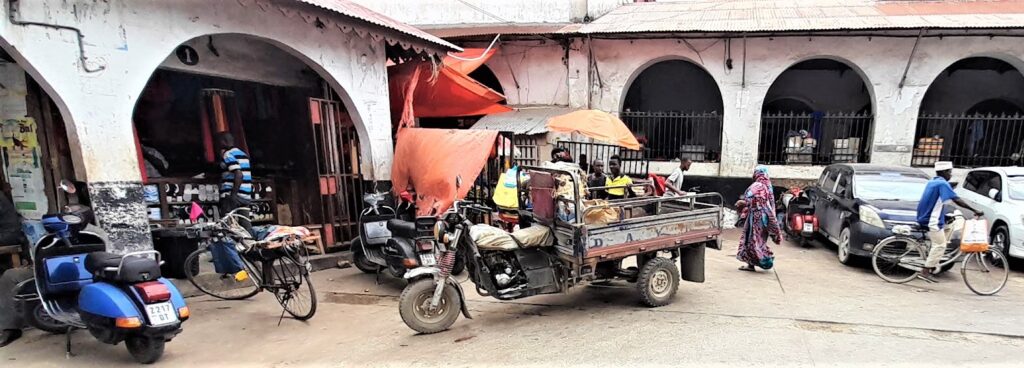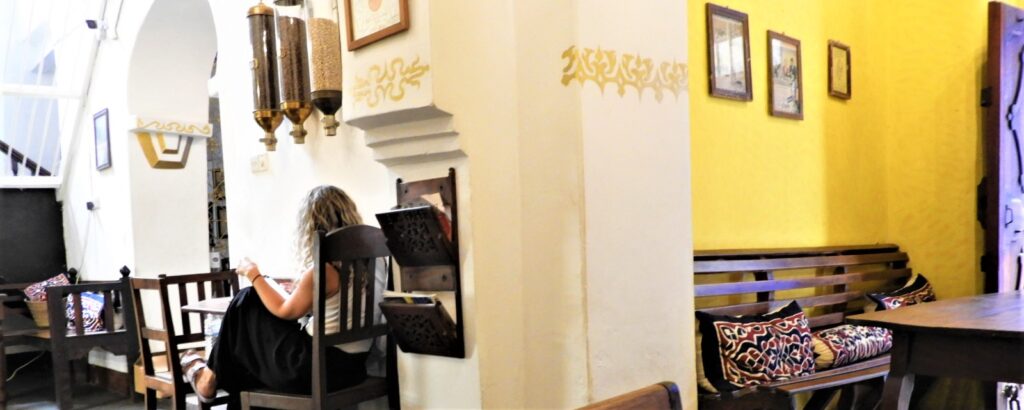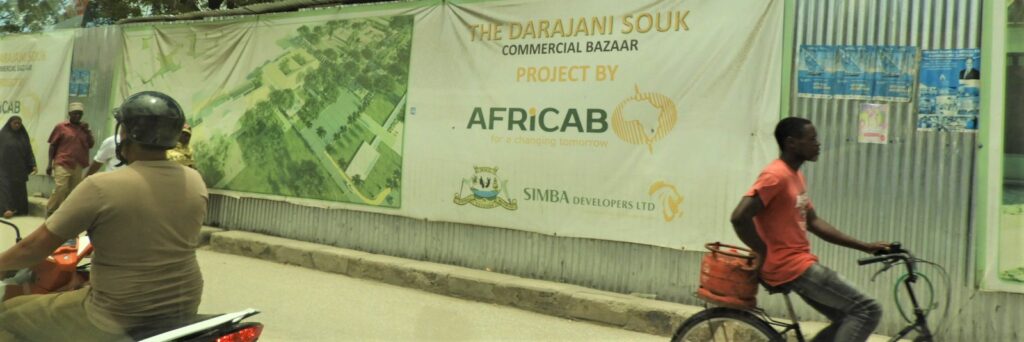Archive for September, 2022
» posted on Wednesday, September 28th, 2022 by Linda Lou Burton
Goldfish For Lunch
Linda Lou Burton posting from Flight # LX8300, Edelweiss Airlines, Keflavik Airport, Iceland – Got your calculator? Here’s a math problem for you. If you leave Zanzibar at 10:30 PM Tuesday and land in Zurich at 6:10 AM Wednesday; then leave Zurich at 1 PM and arrive in Iceland at 2:55 PM; and you change time zones by 3 hours overall, what time do you eat lunch? The entire issue becomes irrelevant I suppose, when you fly Edelweiss. Because they give you Goldfish to munch on any time you please! I grabbed a handful of Goldfish bags the minute they were offered and stacked them greedily in my lap.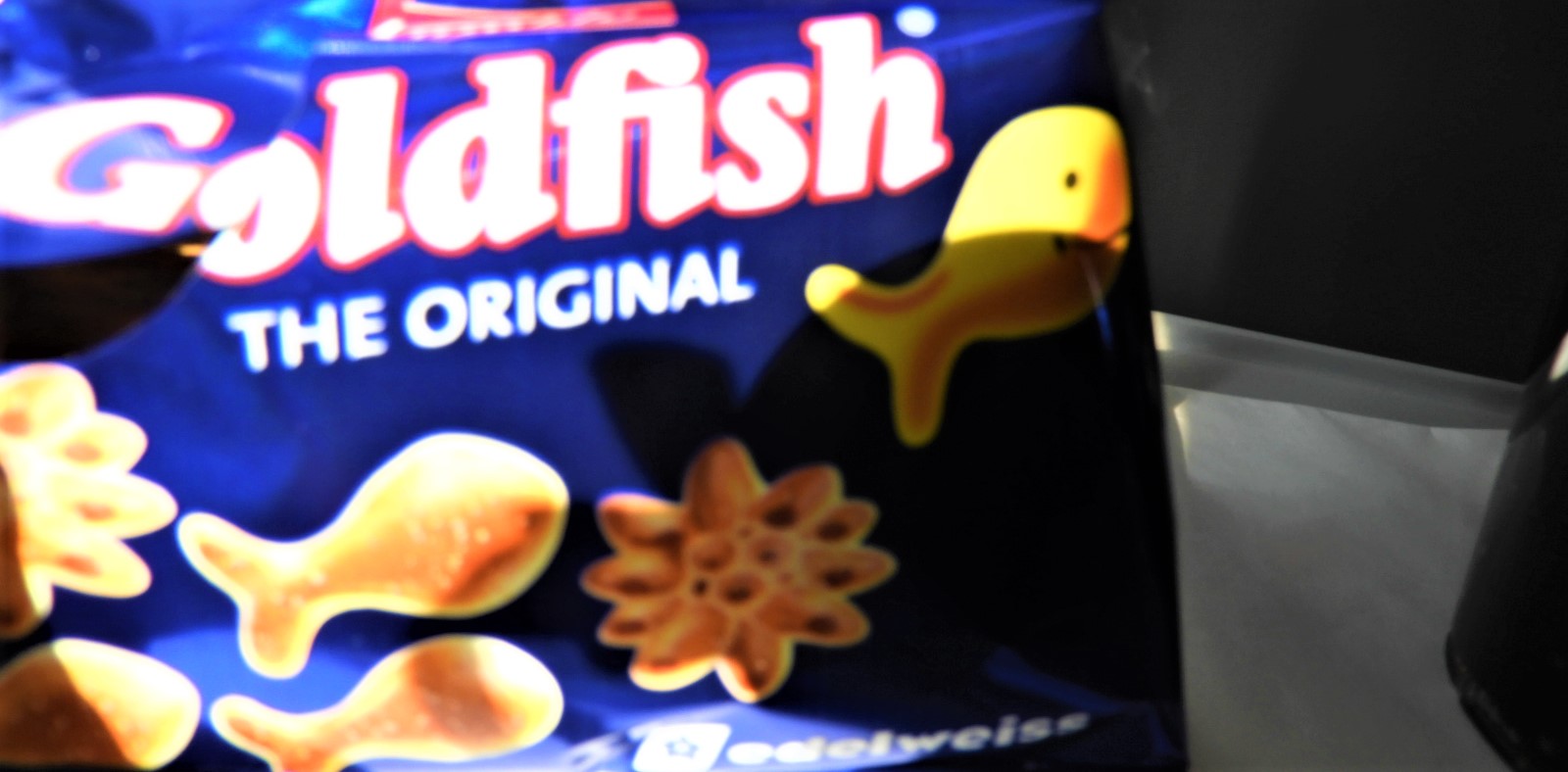
I was living in high country now; our seat row was just behind the curtain separating us from business class (a step up for sure, at least we’re breathing the same air!); I had adequate foot room, and I had a window seat! The flight time from Zurich to Reykjavik’s International Airport was under four hours, so much less daunting that the “getting into Africa” adventures had been. Rick and I both were excited, not quite sure how the climate change was going to hit us. And, for the first time, we were totally on our own. No Globus guides running interference for us or drivers aiming to honor all our whims and preferences. “Flying solo and eating Goldfish,” I laughed to Rick, looking out my window, hoping to see an Alp or two.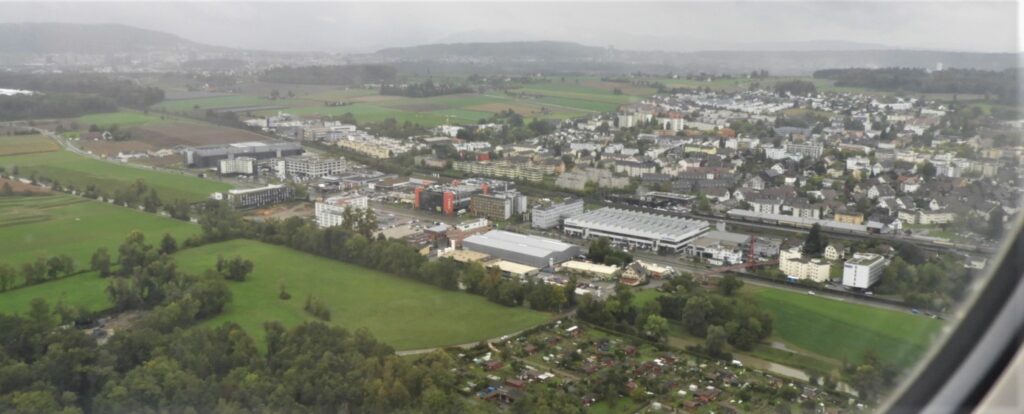
All I saw was green, the brilliant, well-tended green of well-watered farmland; houses neatly rowed in villages. No elephants, no zebras, no giraffes. We flew over the edges of Germany and France; we flew above Belgium, the Netherlands, Scotland. The North Sea. The Atlantic.
Now we’re in Icelandic territory (it’s part of Europe but you can’t get there by car!); the landscape has an unfamiliar look. The ground is a different shade of green; the houses lower; the skies grayer. There’s the airport. The attendant has collected all my empty Goldfish bags so I’m done eating now, and I can give you a surprising factoid about Reykjavik’s International Airport – Keflavik. It was built by the US military during WWII!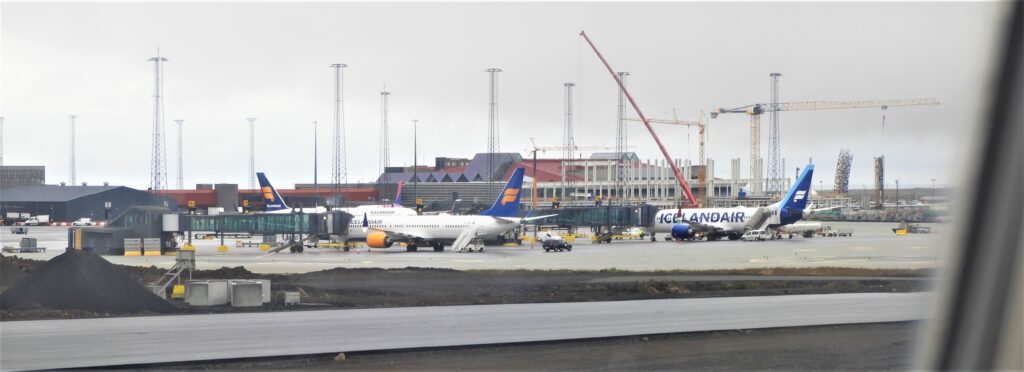
Think about that, and Iceland’s role during the war. Meanwhile, Rick and I will be hunting for a way to get to our hotel. Jackets on.
Zurich Airport https://www.flughafen-zuerich.ch/en/passengers
Keflavik Airport, Reykjavik, Iceland https://www.isavia.is/en/keflavik-airport
Next Post: Fifty Shades of Gray
» posted on Wednesday, September 28th, 2022 by Linda Lou Burton
Einstein Missed
 Linda Lou Burton posting from Family Services Lounge, Zurich Airport, Zurich, Switzerland – Yes, there was a reason for choosing a flight with a seven-hour layover. In Switzerland. The reason was the Café Odeon. Making the transition from East Africa’s equatorial region to Iceland’s watery grayness was challenge enough. Why not throw in a quick-flick of European history on the way? We had to stop somewhere in Europe, and when I read about the Odeon, I knew I’d found something so different it would do the trick. This little coffeehouse in downtown Zurich has been around over a hundred years, and its name-dropping list of customers would make any history lover blink.
Linda Lou Burton posting from Family Services Lounge, Zurich Airport, Zurich, Switzerland – Yes, there was a reason for choosing a flight with a seven-hour layover. In Switzerland. The reason was the Café Odeon. Making the transition from East Africa’s equatorial region to Iceland’s watery grayness was challenge enough. Why not throw in a quick-flick of European history on the way? We had to stop somewhere in Europe, and when I read about the Odeon, I knew I’d found something so different it would do the trick. This little coffeehouse in downtown Zurich has been around over a hundred years, and its name-dropping list of customers would make any history lover blink.
Politicians, physicists, writers, musicians, dancers – hey, dancer Mata Hari performed in the cabaret there way back before she was convicted as a spy and executed. There was Benito Mussolini, and Lenin, and Trotsky. There was Somerset Maugham, Erich Maria Remarque, and James Joyce. Add Arturo Toscanini.  Add Albert Einstein. Yes, he was there. Albert earned his PhD at the University of Zurich, and was living there in 1911 when Odeon opened its doors; they say he liked talking with a crowd of students there, hanging out over coffee. So that was my plan: just luck into the table where Einstein used to sit, and have a coffee (Viennese style), listening for voices from the past.
Add Albert Einstein. Yes, he was there. Albert earned his PhD at the University of Zurich, and was living there in 1911 when Odeon opened its doors; they say he liked talking with a crowd of students there, hanging out over coffee. So that was my plan: just luck into the table where Einstein used to sit, and have a coffee (Viennese style), listening for voices from the past.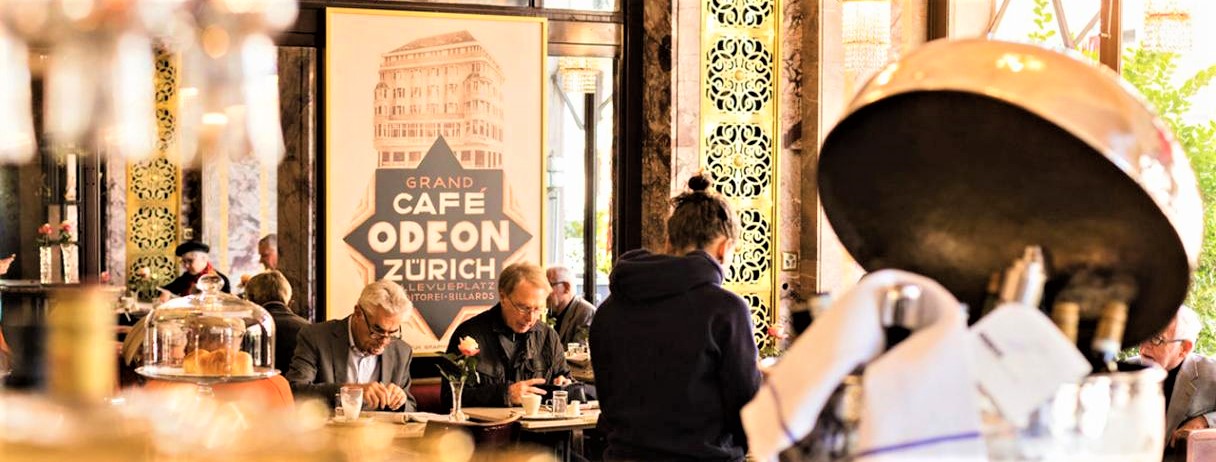
“Imagination is more important than knowledge,” Einstein used to say. I imagined getting off the plane fresh as a daisy at 7 AM; catching the smashingly modern train that rolls right underneath the airport terminal and whisks you downtown in 10 short minutes; strolling along the Limmat River and reaching the Odeon in time for breakfast, served 8-11:30. I’d have a cappuccino with lots of foam and a plaited roll, maybe an omelet? Plenty of time to get back to the airport before our afternoon flight.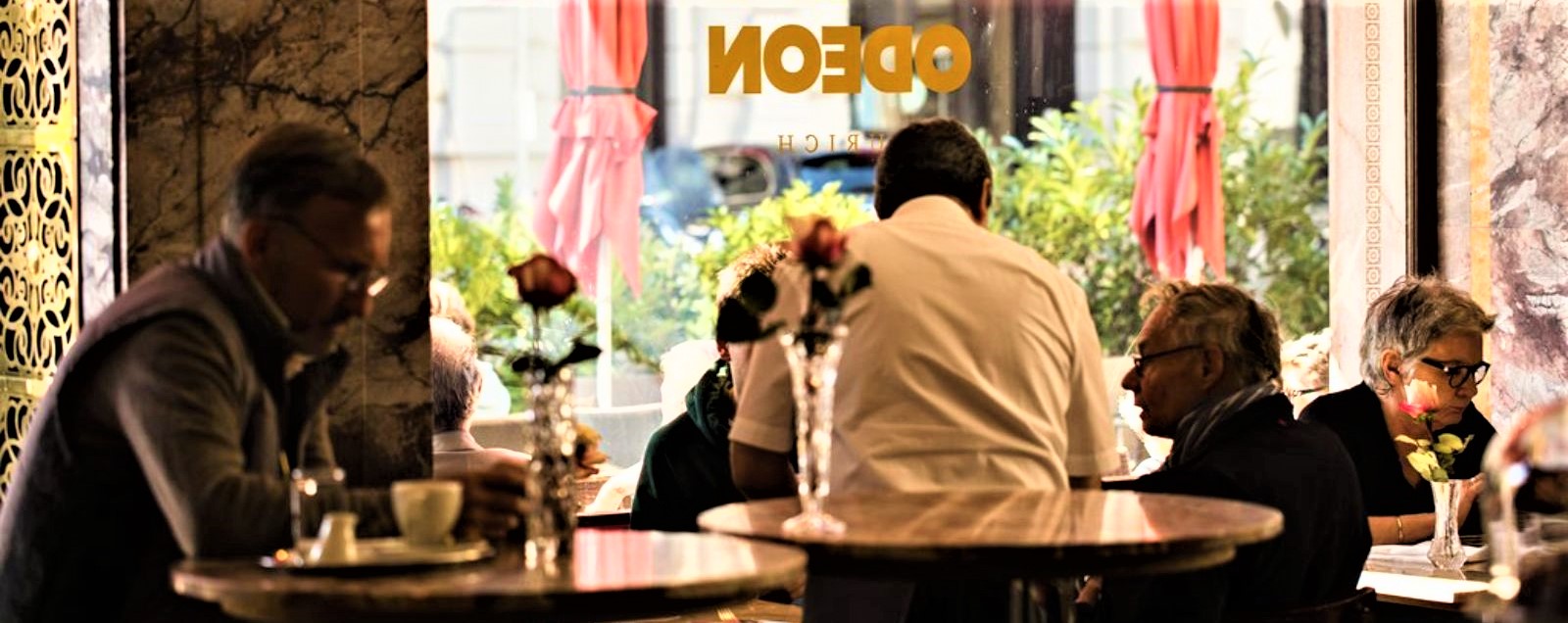
Did that happen? Are you kidding? My wheelchair was waiting as soon as we dragged ourselves off the plane to the ramp after a sitting-up-straight-trying-to-sleep night (and remember, I’m in my night-shirt due to the unfortunate sprite mishap). A kind person pushed me to the Family Services lounge, where Rick and I plopped down and stayed. Hot coffee and cool water right there. Restrooms right there. Peaceful, away from the crowd. Long benches for stretching out for a nap. A restaurant and bookstore just outside the door. My berry muffin was delicious. Rick had a hearty sandwich. No ghosts hovered near; the Euro-techno music kept them away and drove us back to the quiet. Look at the pictures – first what we DID see in the Zurich Airport, and last the Café Odeon, that we did not. Next time, Albert!
Odeon Café Breakfast Menu https://odeon.ch/en/karten/breakfast/
Odeon Café History https://odeon.ch/de/uber-das-odeon/
Zurich Airport https://www.flughafen-zuerich.ch/en/passengers
Next Post: Goldfish For Lunch
» posted on Tuesday, September 27th, 2022 by Linda Lou Burton
Hot Water
Linda Lou Burton posting from Abeid Amani Karume International Airport, Stone Town,  Zanzibar, Tanzania – If I haven’t said it yet, I’ll say it now. A cool, air conditioned van with cushy upholstered seats and a wide sliding door on the side beats a 4×4 for basic travel. No ladder step! No twisting and maneuvering my way to 3rd row back. Zanzibar’s roads were decently smooth too. And then there was Ali, the calmest driver I’ve ever ridden with (and that includes family, friends, and NY cabbies!). Plus he was reassuring. He arrived at the hotel on time; we arrived at the airport on time. He told us to wait as he went inside to make arrangements for my wheelchair. He pushed me quite a long distance into the terminal, introduced me to Mark, the gentleman who would get me all the way through the airport
Zanzibar, Tanzania – If I haven’t said it yet, I’ll say it now. A cool, air conditioned van with cushy upholstered seats and a wide sliding door on the side beats a 4×4 for basic travel. No ladder step! No twisting and maneuvering my way to 3rd row back. Zanzibar’s roads were decently smooth too. And then there was Ali, the calmest driver I’ve ever ridden with (and that includes family, friends, and NY cabbies!). Plus he was reassuring. He arrived at the hotel on time; we arrived at the airport on time. He told us to wait as he went inside to make arrangements for my wheelchair. He pushed me quite a long distance into the terminal, introduced me to Mark, the gentleman who would get me all the way through the airport 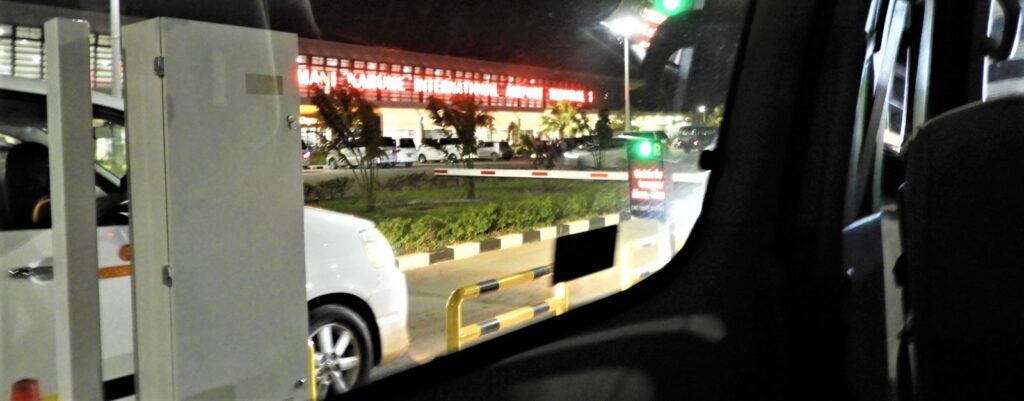 to my gate. And then, goodbye. The airport was sparkling clean with gleaming white tiles; employees were dressed in black. Mark looked immaculate in a black suit, white shirt, black tie. He pushed me (and led Rick) to the counter for checkin. The agent there, a woman also dressed in black (head covered, face not), stepped from behind the counter so she could speak with me eye-to-eye as I sat in my wheelchair. I explained that I’d need a wheelchair in Zurich and Reykjavik, but had not been able to include that in the reservation. She quietly processed everything and handed us our boarding passes, with a smile! Mark then pushed me through a series of check points and x-rays and scans and, yes, a standing-up pat-down by a gloved female. Then a chair right by the gate, with wheelchair waiting to get me all the way to the plane! Needless to say, that set the bar VERY HIGH for airport standards around the world.
to my gate. And then, goodbye. The airport was sparkling clean with gleaming white tiles; employees were dressed in black. Mark looked immaculate in a black suit, white shirt, black tie. He pushed me (and led Rick) to the counter for checkin. The agent there, a woman also dressed in black (head covered, face not), stepped from behind the counter so she could speak with me eye-to-eye as I sat in my wheelchair. I explained that I’d need a wheelchair in Zurich and Reykjavik, but had not been able to include that in the reservation. She quietly processed everything and handed us our boarding passes, with a smile! Mark then pushed me through a series of check points and x-rays and scans and, yes, a standing-up pat-down by a gloved female. Then a chair right by the gate, with wheelchair waiting to get me all the way to the plane! Needless to say, that set the bar VERY HIGH for airport standards around the world.
Until. I asked for some water and a restroom. After my pat-down, I was considered a secured passenger. But alas, even though I was pushed in my wheelchair by airport staff to a restroom, pushed INTO the restroom by said staff, and locked in; even then; I had to go through another standing-up pat-down before returning to my chair. I managed to get a bottle of sprite for me and a fanta orange for Rick on this journey – we hadn’t eaten dinner. Yikes, I won’t move AGAIN, I thought, sipping my sprite in tiny swallows. I had a pain under my rib cage; it always hurts when I’m extremely tired or tense; and the more I thought about it, the worse it got. Eight hours of a tiny seat in coach ahead of me, aahh, I’ll take a Tylenol AND the pain pill my doctor had given me for the absolute worst emergencies. So I did. All my evening meds were in my Pill Minder; hmmm, I’ll take these now too, so I don’t forget. Gulp, gulp.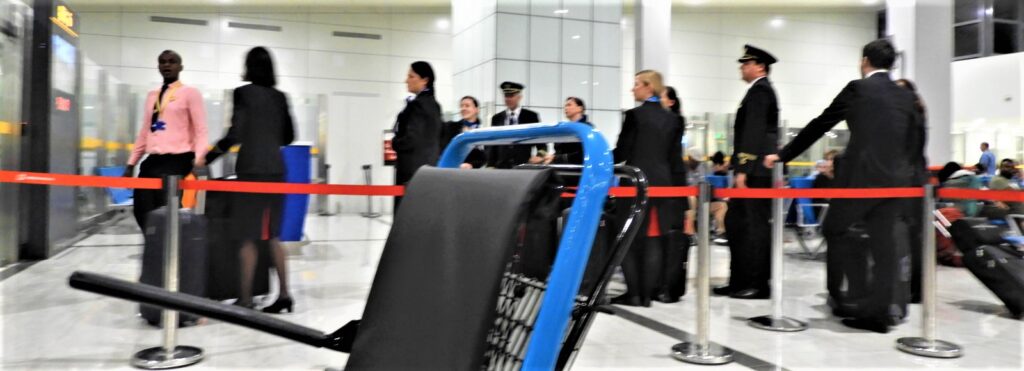
The crew arrived, spiffy in Edelweiss Airlines garb, so European in style! OH MY, I thought – 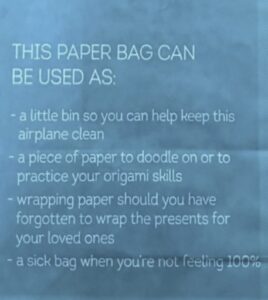 are Friedrich and Frieda part of this crew? I clung to my sprite bottle, determined not to be deprived of something to drink EVER AGAIN. Next thing I know, I’m pushed to the door of the plane, assisted to my seat, and tucked into my 8-hour coach-prison. Rick squeezed into the seat beside; we buckled up. And then it happened. That sprite I’d been sipping on came back up. Just sprite, in two rapid upchucks (gross I know), spilling all down my shirt. I didn’t have time to reach for a Sickness Bag, just pow, there it was – I was soaking wet. Even Rick wasn’t aware of what had happened!
are Friedrich and Frieda part of this crew? I clung to my sprite bottle, determined not to be deprived of something to drink EVER AGAIN. Next thing I know, I’m pushed to the door of the plane, assisted to my seat, and tucked into my 8-hour coach-prison. Rick squeezed into the seat beside; we buckled up. And then it happened. That sprite I’d been sipping on came back up. Just sprite, in two rapid upchucks (gross I know), spilling all down my shirt. I didn’t have time to reach for a Sickness Bag, just pow, there it was – I was soaking wet. Even Rick wasn’t aware of what had happened!
Sometimes an angel is one step ahead of us. When I zipped up fancy-schmancy in the hotel, things just didn’t fit, so my blue-knit night-shirt got crammed into my backpack. First time on the entire trip I’d put any clothing there. Awesome, I’m thinking, sitting there now soaking wet. I can go to the restroom with my backpack, get out my night-shirt, clean up, dry off, and nobody needs to know of my mishap. We were on the row right in front of the restrooms; just a swift step in. Blue-knit night-shirt looked like a tee shirt; I tucked up some of its length; good to go. Back to my seat. Buckled.
The flight attendants were busy getting everyone settled in. The pain under my rib cage continued, the stress building. At home, a Tylenol and my electric heating pad take care of that problem. No heating pads here. Then I remembered the lovely hot water bottles tucked into our bed in the tent camps, all cozily wrapped in flannel, so comforting! Ah, an idea; surely they’d have such a thing on airplanes too! I signaled to an attendant (no, she didn’t look anything like Freida). “Could you bring me a hot water bottle, please?” This fell into the realm of an answer on Jeopardy. “A hot water bottle? You want a bottle of hot water?” She looked genuinely puzzled. I explained about these strange bottles filled with hot water that one could place against ones body for warmth, or to ease pain.
 “Pain?” she said, eyebrows raised. “You are in pain? Where is your pain?” Before I realized how my answer would affect the next moments, I replied “In my chest.” This set off a series of alarms and commotion befitting the arrival of a baby or something equally monumental. Suddenly a nurse appeared; the passenger across the aisle announced he was a doctor. Questions, questions, questions. “They are going to haul me off this plane,” I realized. “It’s my RIGHT side,” I said, as fast as I could think. “It’s a surgical scar! Sometimes it acts up!” What kind of surgery? How long ago? Ten minutes of questioning ensued before calm finally settled in. The aisle began to clear. Rick, and the passenger on the other side of me, each patted my shoulder. “Whew, that was close.”
“Pain?” she said, eyebrows raised. “You are in pain? Where is your pain?” Before I realized how my answer would affect the next moments, I replied “In my chest.” This set off a series of alarms and commotion befitting the arrival of a baby or something equally monumental. Suddenly a nurse appeared; the passenger across the aisle announced he was a doctor. Questions, questions, questions. “They are going to haul me off this plane,” I realized. “It’s my RIGHT side,” I said, as fast as I could think. “It’s a surgical scar! Sometimes it acts up!” What kind of surgery? How long ago? Ten minutes of questioning ensued before calm finally settled in. The aisle began to clear. Rick, and the passenger on the other side of me, each patted my shoulder. “Whew, that was close.”
And then, the nice non-Freida attendant was back. “I have a hot water bottle for you,” she said. “I hope this helps.” She had taken a two-liter sprite bottle, filled it with water, wrapped it in a towel, and microwaved it. The plane took off. I left Africa wearing a blue-knit night-shirt overlain by a bottle of hot water. Adventure 101, I passed.
Fisherman’s Tours https://fishermantours.com/
Abeid Amani Karume International Airport https://www.zaa.go.tz/
Next Post: Einstein Missed
» posted on Tuesday, September 27th, 2022 by Linda Lou Burton
Till Time To Go
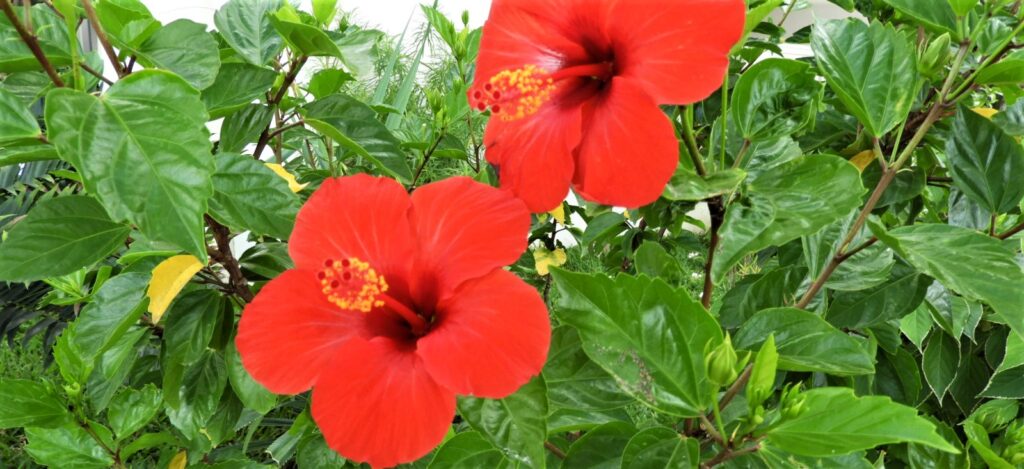 Linda Lou Burton posting from Zanzibar Serena Hotel, Stone Town, Zanzibar, Tanzania –
Linda Lou Burton posting from Zanzibar Serena Hotel, Stone Town, Zanzibar, Tanzania – 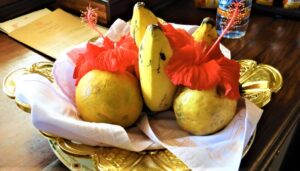 They left a bowl of fruit and flowers in our room when they cleaned every day. I’m sitting on our porch now, eating a banana, thinking about, well, food. People were curious about what we’d eat in Africa. I had studied in advance – what grows there, how it’s prepared, absolute favorites. I vowed to try “at least a bite” of as many different things as I could, although our brains and stomachs tend to crave the familiar. Beans, corn, greens, tomatoes – familiars to me that I knew I’d find in Africa. I knew there would be more dishes featuring bananas and coconut than I have in my routine; I was looking forward to that. So how did it turn out? Here are 10 Things I read about ahead of time:
They left a bowl of fruit and flowers in our room when they cleaned every day. I’m sitting on our porch now, eating a banana, thinking about, well, food. People were curious about what we’d eat in Africa. I had studied in advance – what grows there, how it’s prepared, absolute favorites. I vowed to try “at least a bite” of as many different things as I could, although our brains and stomachs tend to crave the familiar. Beans, corn, greens, tomatoes – familiars to me that I knew I’d find in Africa. I knew there would be more dishes featuring bananas and coconut than I have in my routine; I was looking forward to that. So how did it turn out? Here are 10 Things I read about ahead of time:
- Ugali – maize is a major crop in Kenya and Tanzania. Ugali is standard fare; everybody eats it! Take cornmeal, boil it into a paste; roll it into a ball; eat it with your soups or stews or anything. Like the cornbread I grew up on, only boiled not baked. Did I eat ugali? I honestly don’t know! I tried lots of breads but don’t remember seeing “balled paste” on the Serena buffets. I think I’ll try making it at home, just to be sure.
- Githeri – a favorite in the Kikuyu community; corn and beans, first boiled, then fried. Avocado is often added; all served on rice. Sounds a bit like Mexican food I’ve eaten, agree?
- Ingoho – like the Thanksgiving turkey, Ingoho – chicken – is prepared in Kenya as a special meal; roast the chicken until it is brown; then braise it with onions, tomatoes and spices.
- Kachumbari – claims to be Kenya’s “most delicious salad.” Thin slices of fresh ripe tomatoes, onions, green/red peppers, lemon juice, coriander. I don’t remember seeing the name tag on our buffet’s selections, but every meal had interesting (and beautiful) salads. All delicious.
- Mandazi – oh yes! A very popular sweet! The dough is made with sugar, flour, water, yeast, coconut milk (ground peanuts or almonds can be added). Fry in hot oil, dust with powdered sugar or cinnamon, eat for breakfast or anytime! I remember this one.
- Mchemsho – this means “something boiled” and could be any number of vegetables such as potatoes, green beans, carrots, tomatoes, cabbage, eggplant. Definitely ate this!
- Mukimo –I’ll be making this at home. Mash some potatoes, then add spinach, corn, peas, whatever, for added flavor. I’ve made colcannon (around St Paddy’s day); love it!
- Ndizi na nyama – a favorite in Tanzania this is bananas (ndizi) and meat (nyama) made into a stew with curry powder, cayenne pepper, oil, onions, tomatoes, and coconut milk. Simmer then serve with rice, or ugali! I don’t remember seeing this but I think I’ll try it at home.
- Nyama Choma – Swahili for “grilled meat;” both countries are fond of goat, beef, chicken or fish grilled over charcoal. Our bush meals usually had a grill going for an outdoor feast.
- Rice – rice was everywhere, cooked every which way. In Tanzania, Wali wa nazi is rice cooked in coconut milk and water, seasoned only with salt. In Kenya Pilau is a special rice cooked with spices and chicken or beef.
 Why am I thinking about FOOD as I sit on our porch in Zanzibar, till time to get on a plane headed far, far north? A change awaits us in Iceland, for sure! I’m ticking off their favorites in my head: skyr (kind of like yogurt); ice cream and cheese (yes, they are mad about ice cream!); rye bread and butter (I can dig that); lamb (lamb stew, lamb roasted, lamb sirloin?) and, of course, FISH. Icelanders eat fish every single day. Pretty popular in Zanzibar too, I’m thinking, as another fishing boat goes by. Ali is picking us up at 7, better zip up the old fancy-schmancy suitcase, one more time. Look at these flowers we’ve been enjoying here by the Indian Ocean, while I go back inside a minute. We won’t see them in Iceland!
Why am I thinking about FOOD as I sit on our porch in Zanzibar, till time to get on a plane headed far, far north? A change awaits us in Iceland, for sure! I’m ticking off their favorites in my head: skyr (kind of like yogurt); ice cream and cheese (yes, they are mad about ice cream!); rye bread and butter (I can dig that); lamb (lamb stew, lamb roasted, lamb sirloin?) and, of course, FISH. Icelanders eat fish every single day. Pretty popular in Zanzibar too, I’m thinking, as another fishing boat goes by. Ali is picking us up at 7, better zip up the old fancy-schmancy suitcase, one more time. Look at these flowers we’ve been enjoying here by the Indian Ocean, while I go back inside a minute. We won’t see them in Iceland!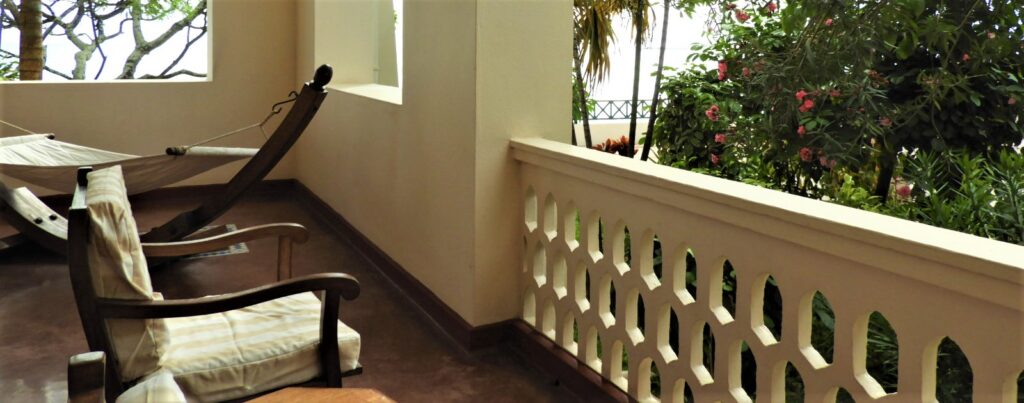
Credit Rick with the flower closeups.
Zanzibar Serena Hotel https://www.serenahotels.com/zanzibar
Fisherman’s Tours https://fishermantours.com/
Next Post: Hot Water
» posted on Tuesday, September 27th, 2022 by Linda Lou Burton
The Guard Made The Day
Linda Lou Burton posting from Zanzibar Serena Hotel, Stone Town, Zanzibar, Tanzania – 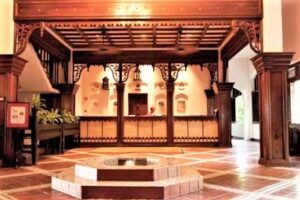 Our plane was not due to leave the airport till 10:30 PM today. It was the only flight this entire week headed from Zanzibar to where we wanted to go. 10:30 PM Tuesday, a flight to Zurich, then Iceland. One flight per week. Otherwise we’d have to fly, or ferry, to the airport on the mainland, Dar es Salaam, 30 miles away; then fly from there. The good thing was – the late flight gave us another full day to enjoy Zanzibar! Our hotel desk was agreeable, no extra charge. Our transport was arranged with Ali from the day before – he’d get us to the airport in plenty of time and
Our plane was not due to leave the airport till 10:30 PM today. It was the only flight this entire week headed from Zanzibar to where we wanted to go. 10:30 PM Tuesday, a flight to Zurich, then Iceland. One flight per week. Otherwise we’d have to fly, or ferry, to the airport on the mainland, Dar es Salaam, 30 miles away; then fly from there. The good thing was – the late flight gave us another full day to enjoy Zanzibar! Our hotel desk was agreeable, no extra charge. Our transport was arranged with Ali from the day before – he’d get us to the airport in plenty of time and  help us through the Tanzanian hoops. So why the heck did Rick have his suitcase zipped and ready to go at 9 AM? There he sat, long warm pants on, long sleeves, decked out for cooler weather. Arms folded, hat on, sitting in a straight-back chair! “Do you want to go on another Tour today?” I asked. “We have plenty of time.” There were
help us through the Tanzanian hoops. So why the heck did Rick have his suitcase zipped and ready to go at 9 AM? There he sat, long warm pants on, long sleeves, decked out for cooler weather. Arms folded, hat on, sitting in a straight-back chair! “Do you want to go on another Tour today?” I asked. “We have plenty of time.” There were  two more Tours that we’d talked about; one to Prison Island, which would give us a cruise on the Indian Ocean for about 30 minutes and the chance to visit with giant tortoises that live there. The Jozani Forest tour was another; it would give us a chance to spot the red colobus monkey, a species that only lives on Zanzibar. But we agreed; our
two more Tours that we’d talked about; one to Prison Island, which would give us a cruise on the Indian Ocean for about 30 minutes and the chance to visit with giant tortoises that live there. The Jozani Forest tour was another; it would give us a chance to spot the red colobus monkey, a species that only lives on Zanzibar. But we agreed; our 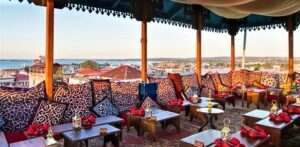 animal count to date was high enough for one trip. We thought about a few restaurants – one in particular, the fancy Tea House where you sat on cushions on the floor, gazing across the rooftops to the sea; the other a hangout bar, named for Freddie Mercury, right on the beach. “Or we can just sit here on our beautiful porch and look at the Indian Ocean,” I said. And then I remembered – I have not yet touched the Indian Ocean – one of my main reasons for being here!
animal count to date was high enough for one trip. We thought about a few restaurants – one in particular, the fancy Tea House where you sat on cushions on the floor, gazing across the rooftops to the sea; the other a hangout bar, named for Freddie Mercury, right on the beach. “Or we can just sit here on our beautiful porch and look at the Indian Ocean,” I said. And then I remembered – I have not yet touched the Indian Ocean – one of my main reasons for being here!
Here’s where our Serena Hotel sits; this point jutting out into the Ocean; facing west, looking towards the mainland. Its history is marvelous; it’s really two historic buildings joined together – an 18th Century Chinese doctor’s home and a 19th Century office building. They were careful, when turning the spaces into a hotel, to preserve the original architecture and the decorative finishes; or to restore them if necessary. It is “Zanzibar Style” – you expect to come face to face with a Sultan any moment. Arabic and Swahili designs, tiles, wood finishes, cool whites and blues. Gardens. One other thing Zanzibar Style means is “close together.” Buildings touch buildings, all around the oceanfront. Our Serena is midway, see the turquoise pool our room overlooks? Below is another view of the hotel, our room is ground floor, right in front of the boat’s sail. The pool is left of the sail, see the umbrellas?
 A Security Guard paced the sidewalk between our porch and the ocean, back and forth, day and night. We’d become nodding acquaintances with our daytime guard; he was a friendly fellow; making sure nobody on the BEACH climbed into our secure hotel space. There was a high wall (for high tide) and a wooden fence above that. Which also kept hotel guests from accessing the beach, directly. I caught his attention, stepped out to ask: “How can I get to the beach?” He told me I’d need to go to Forodhani Park. I pointed to the rickety wooden steps by our pool, behind a locked gate. “Would you unlock the gate and allow me to walk down, just for a minute?” I went into my long story – my plan for dipping my foot into ALL FIVE oceans; I had the first four, this was Number Five. And we were leaving TODAY. I put on my sweetest plaintive smile. He smiled back. “It’s too dangerous,” he said. “Just look.” We peered over the gate together. There was no rail (a bad sign for me, the rail-grabber.) The tide was about halfway out (or in), jagged rocks lay against the base of the wall, water fiercely lapping against stone. “I simply cannot allow you on these steps,” the guard said. “It’s treacherous.” Well in fact, it was, for me, for sure. “I just need the WATER,” I said. “I don’t need to walk ON the beach. So, would you walk down a few steps, get some Indian Ocean water on your hands, and then just SPRINKLE it on my feet?” This set off so much laughter between the guard and Rick; so many grins exchanged over an old lady’s head, that, next thing you know, he unlocked that gate and headed down those treacherous steps.
A Security Guard paced the sidewalk between our porch and the ocean, back and forth, day and night. We’d become nodding acquaintances with our daytime guard; he was a friendly fellow; making sure nobody on the BEACH climbed into our secure hotel space. There was a high wall (for high tide) and a wooden fence above that. Which also kept hotel guests from accessing the beach, directly. I caught his attention, stepped out to ask: “How can I get to the beach?” He told me I’d need to go to Forodhani Park. I pointed to the rickety wooden steps by our pool, behind a locked gate. “Would you unlock the gate and allow me to walk down, just for a minute?” I went into my long story – my plan for dipping my foot into ALL FIVE oceans; I had the first four, this was Number Five. And we were leaving TODAY. I put on my sweetest plaintive smile. He smiled back. “It’s too dangerous,” he said. “Just look.” We peered over the gate together. There was no rail (a bad sign for me, the rail-grabber.) The tide was about halfway out (or in), jagged rocks lay against the base of the wall, water fiercely lapping against stone. “I simply cannot allow you on these steps,” the guard said. “It’s treacherous.” Well in fact, it was, for me, for sure. “I just need the WATER,” I said. “I don’t need to walk ON the beach. So, would you walk down a few steps, get some Indian Ocean water on your hands, and then just SPRINKLE it on my feet?” This set off so much laughter between the guard and Rick; so many grins exchanged over an old lady’s head, that, next thing you know, he unlocked that gate and headed down those treacherous steps.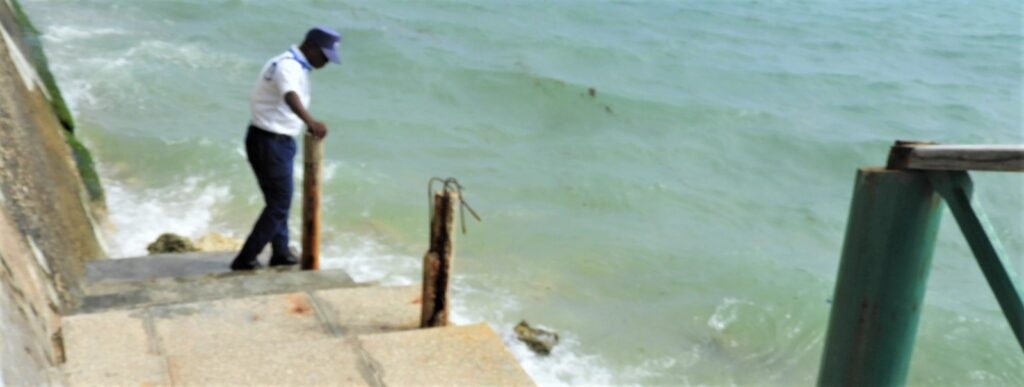

 He was WADING in the waves; his shoes, his PANTS were getting soaked. “Just a teeny bit of water is OK!” I shouted down. “Be careful!” And then, he spotted a plastic bottle floating, banging against the rocks. This (precious, sweetheart) guard grabbed it, rinsed it out, and hopped back up the steps with an entire BOTTLE of Indian Ocean water! He poured it on my left foot! He poured it on my right foot! He laughed! Rick laughed! I squealed like a kid! Sometimes the most unexpected thing can lead to a tick mark on a bucket list. Ocean #5 is now on my feet! Just 78 years after Ocean #1.
He was WADING in the waves; his shoes, his PANTS were getting soaked. “Just a teeny bit of water is OK!” I shouted down. “Be careful!” And then, he spotted a plastic bottle floating, banging against the rocks. This (precious, sweetheart) guard grabbed it, rinsed it out, and hopped back up the steps with an entire BOTTLE of Indian Ocean water! He poured it on my left foot! He poured it on my right foot! He laughed! Rick laughed! I squealed like a kid! Sometimes the most unexpected thing can lead to a tick mark on a bucket list. Ocean #5 is now on my feet! Just 78 years after Ocean #1. 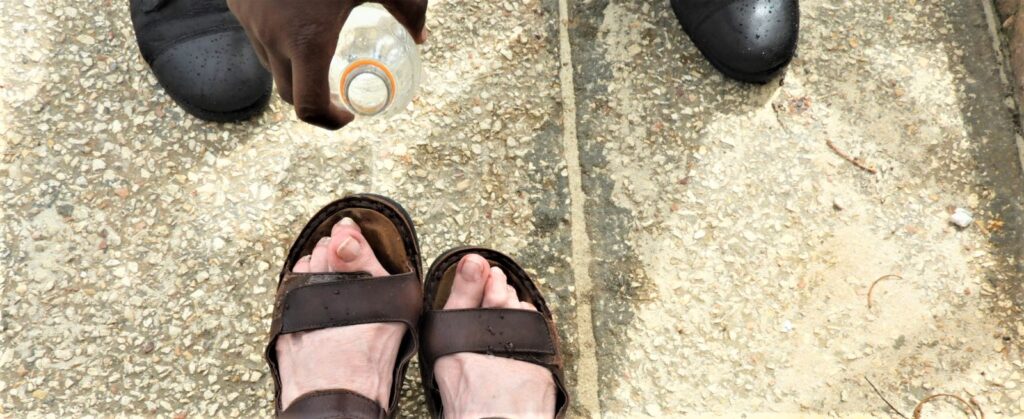
The guard made my day. Of course I tipped him generously!
Zanzibar Serena Hotel https://www.serenahotels.com/zanzibar
Fisherman’s Tours https://fishermantours.com/
Next Post: Till Time To Go
» posted on Monday, September 26th, 2022 by Linda Lou Burton
A Spicy Afternoon
Linda Lou Burton posting from Zanzibar Serena Hotel, Stone Town, Zanzibar, Tanzania – 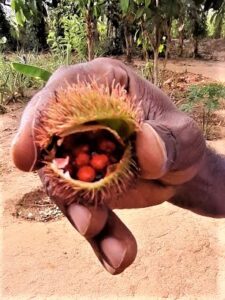 Cinnamon is tree bark. A pineapple plant produces only ONE pineapple. And the lipstick tree (no, I’m not kidding) has little red berries inside its spiny smooch-smooch pod that some people (have been known to) use to redden their lips. All of this was news to me! Cinnamon is TREE BARK? That’s right, that beloved wonderful-smelling stuff Mother would sprinkle on toast for me (a picky-eater-kid) comes from the bark of a tree. Imagine this: you scrape off the outer bark of a cinnamon tree (it’s an evergreen); then you cut out the inner bark, in strips. As the bark dries, it rolls into a
Cinnamon is tree bark. A pineapple plant produces only ONE pineapple. And the lipstick tree (no, I’m not kidding) has little red berries inside its spiny smooch-smooch pod that some people (have been known to) use to redden their lips. All of this was news to me! Cinnamon is TREE BARK? That’s right, that beloved wonderful-smelling stuff Mother would sprinkle on toast for me (a picky-eater-kid) comes from the bark of a tree. Imagine this: you scrape off the outer bark of a cinnamon tree (it’s an evergreen); then you cut out the inner bark, in strips. As the bark dries, it rolls into a  curl. The dried curls are cut into “quills” 2-4 inches long for sale. Somehow or other this delicious tree bark winds up powdered on bread making cinnamon toast for picky kids. Or cinnamon rolls for everybody. We couldn’t even have Halloween Red Hots without that fragrant tree bark! That’s just part of what we learned this afternoon at the Jambo Spice Farm, where things that sit in everybody’s kitchen cabinet take on an exotic aura. Like cloves, the “Emperor of Spices”; like nutmeg, turmeric, cardamom, black pepper. You should have been there!
curl. The dried curls are cut into “quills” 2-4 inches long for sale. Somehow or other this delicious tree bark winds up powdered on bread making cinnamon toast for picky kids. Or cinnamon rolls for everybody. We couldn’t even have Halloween Red Hots without that fragrant tree bark! That’s just part of what we learned this afternoon at the Jambo Spice Farm, where things that sit in everybody’s kitchen cabinet take on an exotic aura. Like cloves, the “Emperor of Spices”; like nutmeg, turmeric, cardamom, black pepper. You should have been there!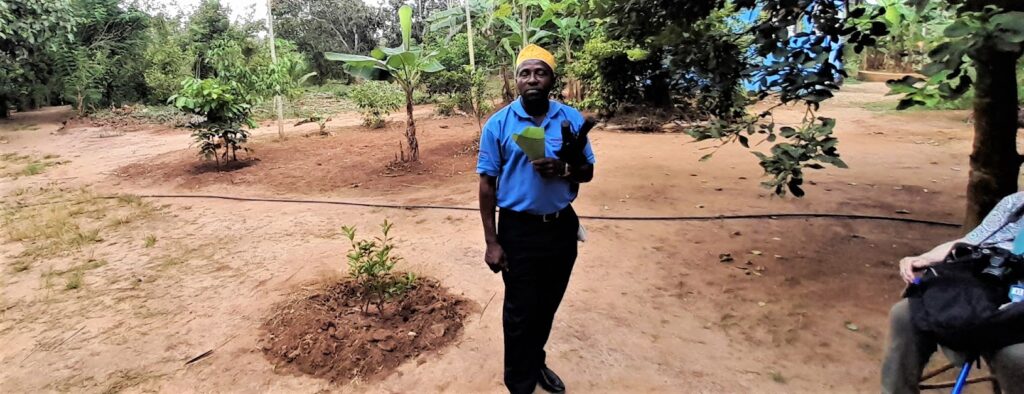
Ali drove, and Said led the tour, along with locals on the farm; a jungley maze of green to wander through on a warm afternoon. No crowds, no hurry, just stop, look, smell, and taste. Touch a banana while it’s hanging on the tree, still growing. Watch a brave soul shimmy up a 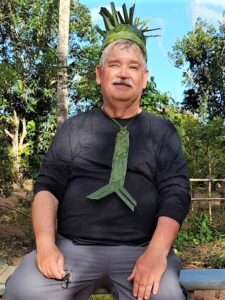 coconut tree while everyone below chants him higher, higher, daring. Rick wound up with a hat and a tie made of woven coconut leaves (and he didn’t have to climb the tree). I gained a new appreciation for the gardening tactics regarding pineapple. Cut off the top and plant it so it can make another plant. Eat the pineapple fruit. Repeat. As for the lipstick tree: those bright red berries actually are used in industrial dyes for food preparation and cosmetics. My vote for prettiest just-off-the-tree spice was the nutmeg – once you open the outer shell it looks like you’ve lucked into a fancily-decorated chocolate bon-bon. Don’t you think?
coconut tree while everyone below chants him higher, higher, daring. Rick wound up with a hat and a tie made of woven coconut leaves (and he didn’t have to climb the tree). I gained a new appreciation for the gardening tactics regarding pineapple. Cut off the top and plant it so it can make another plant. Eat the pineapple fruit. Repeat. As for the lipstick tree: those bright red berries actually are used in industrial dyes for food preparation and cosmetics. My vote for prettiest just-off-the-tree spice was the nutmeg – once you open the outer shell it looks like you’ve lucked into a fancily-decorated chocolate bon-bon. Don’t you think?
Jambo Spice Farm is a 30-minute drive from Stone Town, in a cluster of spice-growing farms – Abeid, Badru, SISO, Tangawizi; and near the Zanzibar Agricultural Research Institute and the School of Agriculture. The drive passes along the coastline, turning eastward at Bububu.
Why do spices grow so profusely in Zanzibar? Perfect soil and climate – plenty of rain and always, always warm.
Zanzibar Serena Hotel https://www.serenahotels.com/zanzibar
Fisherman’s Tours https://fishermantours.com/
Zanzibar School of Agriculture https://suza.ac.tz/soa/
Next Post: The Guard Made The Day
» posted on Monday, September 26th, 2022 by Linda Lou Burton
Food, Facts, & A Fort
Linda Lou Burton posting from Zanzibar Serena Hotel, Stone Town, Zanzibar, Tanzania – Who doesn’t love pizza? The minute I saw “pizza” on the menu I knew that’s what I was ordering. I’d read about “Zanzibar Pizza” and was dying to try it – not Italian pizza, but Zanzibar pizza. You take unleavened dough, stretch it thin and fill it with beef, chicken, seafood, vegetables, cheese, eggs, whatever you please. Then you wrap the sides around, throw it into a pan full of butter, and fry it to a crispy gold! You can also make it sweet: bananas, mangoes, chocolate spread, even peanut butter. We’d had our Zanzibar coffee  earlier, now with the Walking Tour done, Rick and I were in a tiny restaurant-by-the-sea for our lunch break. Said and Ali would fetch us later for our ride south to the Spice Farm. Lots to talk about – Rick had wandered through several hundred years of civilization in the last few hours. Stone Town is on Unguja, the largest of the Zanzibar Archipelago’s four main islands; it is 53 miles long and 24 miles wide, about 25 miles from Tanzania’s mainland. Zanzibar’s population (all islands) is under 2 million. Zanzibar City, of which Stone Town is a part, is the capital of this semi-autonomous province-within-a-country. That’s the geography. We needed to get Zanzibar’s HISTORY unscrambled in our heads, so, dates next.
earlier, now with the Walking Tour done, Rick and I were in a tiny restaurant-by-the-sea for our lunch break. Said and Ali would fetch us later for our ride south to the Spice Farm. Lots to talk about – Rick had wandered through several hundred years of civilization in the last few hours. Stone Town is on Unguja, the largest of the Zanzibar Archipelago’s four main islands; it is 53 miles long and 24 miles wide, about 25 miles from Tanzania’s mainland. Zanzibar’s population (all islands) is under 2 million. Zanzibar City, of which Stone Town is a part, is the capital of this semi-autonomous province-within-a-country. That’s the geography. We needed to get Zanzibar’s HISTORY unscrambled in our heads, so, dates next.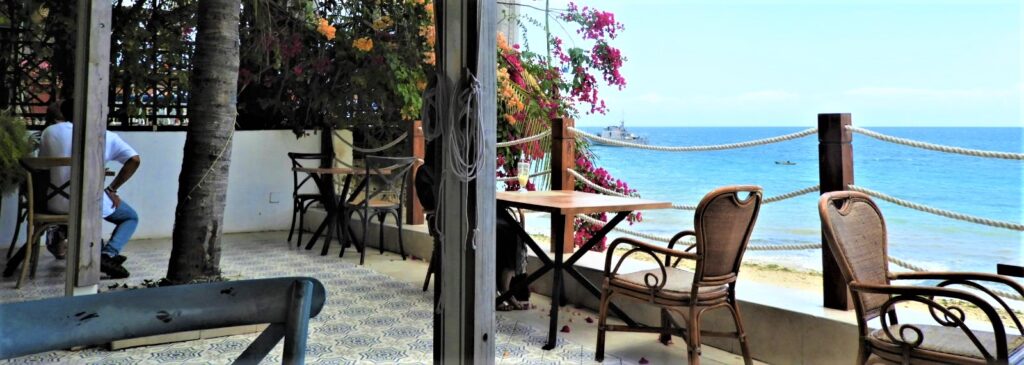
10 Significant Dates (among many!):
- 1498 – Portugal’s Vasco da Gama visited the islands
- 1571 – Zanzibar became part of the Portuguese Empire
- 1635 – Portuguese established a fort on Pemba Island
- 1698 – Zanzibar came under influence of the Sultan of Oman
- 1699 –Omani’s expelled the Portuguese, built fort in Stone Town
- 1784 – Brief revolt against Omani rule
- 1890 – Zanzibar became a protectorate of Great Britain
- 1963 – British protectorate terminated, Zanzibar became monarchy
- 1964 – Sultan deposed, Zanzibar became Peoples Republic
- 1964 – Zanzibar merged with Tanganyika to become Tanzania
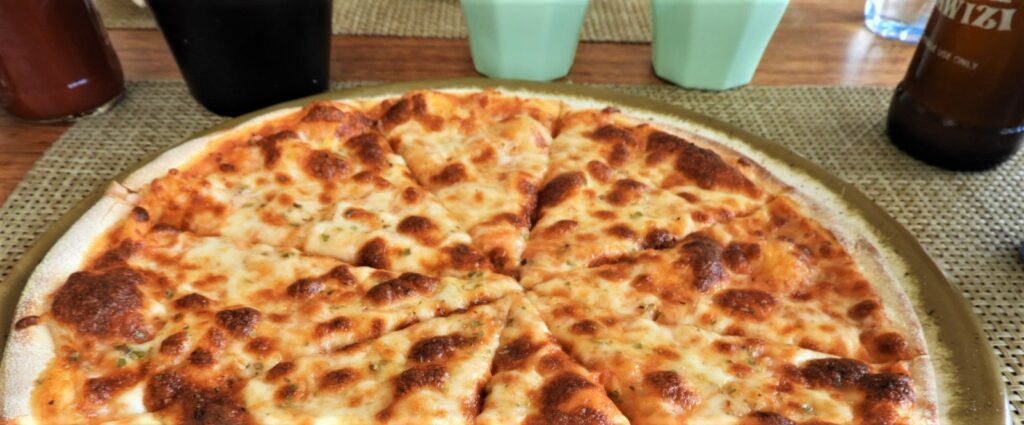 Oops, here are our pizzas, looking very American. “Sorry, we don’t serve Zanzibar pizza here,” our server explained. Okay then, something familiar! “Just tell me about two things you saw this morning,” I said to Rick as I scarfed down my cheesy pizza. “Your favorites.”
Oops, here are our pizzas, looking very American. “Sorry, we don’t serve Zanzibar pizza here,” our server explained. Okay then, something familiar! “Just tell me about two things you saw this morning,” I said to Rick as I scarfed down my cheesy pizza. “Your favorites.”
His picks: the coral stone used for building construction and the Old Fort.
Stone Town was named “Stone Town” because its buildings were mainly built with coral stone, giving the town a warm color. Look at this alley wall!
The Old Fort is on the main seafront, by the House of Wonders, facing Forodhani Gardens. History: it was built by Omani Arabs after chasing away the Portuguese in 1699. It was used as a garrison and prison in the 19th century. In the early 20th century it was a depot as the railway that connected Stone Town to the village of Bububu (named for the sound a steam engine makes as it passes by bububububu) was being constructed. A new guardhouse was built in 1947 and used as the ladies’ club. And, thoroughly modern — its amphitheater is now the headquarters of the Zanzibar international film festival!
Zanzibar Serena Hotel https://www.serenahotels.com/zanzibar
Fisherman’s Tours https://fishermantours.com/
Next Post: A Spicy Afternoon
» posted on Monday, September 26th, 2022 by Linda Lou Burton
Sultans and Slavers
Linda Lou Burton posting from Zanzibar Serena Hotel, Stone Town, Zanzibar, Tanzania – “A fabled land of spices and a vile center of slavery.” That was Zanzibar’s world-wide reputation back in the 19th century. It was, in fact, the main slave-trading port of the African Great Lakes region; as many as 50,000 slaves were passed through the slave markets of Zanzibar each year. David Livingstone, a British missionary and explorer, estimated that 80,000 new slaves died each year before ever reaching the island. Tippu Tip was the most notorious slaver, under several sultans, and also a trader, plantation owner, and governor. 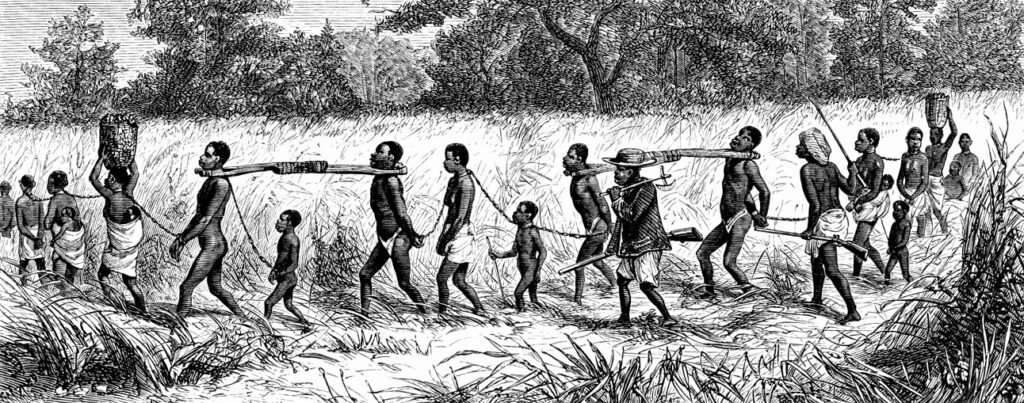 The United Kingdom’s early interest in Zanzibar was motivated both by commerce (all those spices) and by the determination to end the slave trade. In 1822, the British signed the first of a series of treaties with Zanzibar Sultans to curb this trade; the slave trade was officially abolished in 1876 during the rule of Sultan Barghash although slavery itself remained legal in Zanzibar until 1897. Take a look at two main players on the Zanzibari stage.
The United Kingdom’s early interest in Zanzibar was motivated both by commerce (all those spices) and by the determination to end the slave trade. In 1822, the British signed the first of a series of treaties with Zanzibar Sultans to curb this trade; the slave trade was officially abolished in 1876 during the rule of Sultan Barghash although slavery itself remained legal in Zanzibar until 1897. Take a look at two main players on the Zanzibari stage.
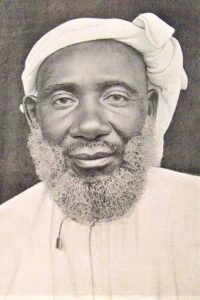 Tippu. Tippu Tip (1832-1905) was an Afro-Omani ivory and slave trader who was born and died in Zanzibar. His real name is longer than I have space for so I’ll use his nickname, which kind of sticks in your head anyway. Tippu Tib, as he was first known, translates to “gatherer together of wealth;” the “Tib” changed to “Tip” because of the “tiptip” sound his guns made during his expeditions. At least, that’s his claim; he wrote a book about himself which was published in Britain in 1907. Either nickname fits; Tippu became a wealthy man trading in slaves for Zanzibar’s clove plantations. He led many expeditions into Central Africa, establishing profitable trading posts deep into the Congo Basin. Between 1884 and 1887 he claimed the Eastern Congo for himself and for the Sultan of Zanzibar, Barghash bin Said el Busaidi. By 1895, he had acquired seven plantations and 10,000 slaves. He became the most well-known slave trader in Africa, supplying much of the world with black slaves.
Tippu. Tippu Tip (1832-1905) was an Afro-Omani ivory and slave trader who was born and died in Zanzibar. His real name is longer than I have space for so I’ll use his nickname, which kind of sticks in your head anyway. Tippu Tib, as he was first known, translates to “gatherer together of wealth;” the “Tib” changed to “Tip” because of the “tiptip” sound his guns made during his expeditions. At least, that’s his claim; he wrote a book about himself which was published in Britain in 1907. Either nickname fits; Tippu became a wealthy man trading in slaves for Zanzibar’s clove plantations. He led many expeditions into Central Africa, establishing profitable trading posts deep into the Congo Basin. Between 1884 and 1887 he claimed the Eastern Congo for himself and for the Sultan of Zanzibar, Barghash bin Said el Busaidi. By 1895, he had acquired seven plantations and 10,000 slaves. He became the most well-known slave trader in Africa, supplying much of the world with black slaves.
 Barghash. Barghash bin Said al-Busaidi (1836-1888) was an Omani Sultan and the second Sultan of Zanzibar, ruling from October 7, 1870 to March 26, 1888. Described as having a sharp and charming character, he is credited with building much of the infrastructure of Stone Town, including piped water, public baths, a police force, roads, parks, hospital, and large administrative buildings such as the House of Wonders. Barghash had a treaty with the British to help stop the slave trade in Zanzibar, but did not always keep his commitment. In June 1873 John Kirk, acting British Consul, received contradictory instructions from London; one to issue an ultimatum to the Sultan that the slave trade must be stopped and the slave market closed, under threat of blockade; the other not to enforce a blockade which might be taken as an act of war. Kirk showed only the first instruction to Barghash, who capitulated, signing a further treaty with Britain prohibiting slave trade in his kingdom, and immediately closing the slave market.
Barghash. Barghash bin Said al-Busaidi (1836-1888) was an Omani Sultan and the second Sultan of Zanzibar, ruling from October 7, 1870 to March 26, 1888. Described as having a sharp and charming character, he is credited with building much of the infrastructure of Stone Town, including piped water, public baths, a police force, roads, parks, hospital, and large administrative buildings such as the House of Wonders. Barghash had a treaty with the British to help stop the slave trade in Zanzibar, but did not always keep his commitment. In June 1873 John Kirk, acting British Consul, received contradictory instructions from London; one to issue an ultimatum to the Sultan that the slave trade must be stopped and the slave market closed, under threat of blockade; the other not to enforce a blockade which might be taken as an act of war. Kirk showed only the first instruction to Barghash, who capitulated, signing a further treaty with Britain prohibiting slave trade in his kingdom, and immediately closing the slave market.
There are 1,709 buildings in Stone Town, a UNESCO World Heritage Site. Major buildings include Christ Church Anglican Cathedral commemorating the work of David Livingstone in abolishing the slave trade and built on the site of the last slave market; the residence of slave trader Tippu Tip; and the House of Wonders, the large ceremonial palace built by Sultan Barghash; all included in Rick’s Walking Tour this morning. I’ll start with the church. 
The church is located in Mkunazini Road, in the center of the old town, and occupies a large area where the biggest slave market of Zanzibar used to be; its construction was to celebrate the end of slavery. The altar is said to be in the exact place where the main “whipping post” of the market was. In the square there is a monument to the slaves showing human figures in chains emerging from a pit.
The last two buildings are the former home of Tippu Tip, and the House of Wonders. Although Stone Town was included in UNESCO’s World Sites in 2000, this designation does not provide complete protection for the town’s heritage. About 80% of the 1,709 buildings are in a deteriorating condition. Some major restoration projects, especially on the seafront, have been done in recent times by the Aga Khan Trust for Culture.
Zanzibar Serena Hotel https://www.serenahotels.com/zanzibar
Fisherman’s Tours https://fishermantours.com/
Next Post: Food, Facts & A Fort
» posted on Monday, September 26th, 2022 by Linda Lou Burton
To Market, To Market
Linda Lou Burton posting from Zanzibar Serena Hotel, Stone Town, Zanzibar, Tanzania –  A fat pig is about the only thing I didn’t see in Darajani Market this morning. Zanzibar is 99% Muslim, and since pork isn’t an approved dietary item in the Islamic religion, you wouldn’t expect to see it in local stores, or on restaurant menus. Beef, chicken, and goat are on the approved list, as well as seafood; so in a country right on the ocean’s coastline, it makes sense that the Fish Market was the first spot I caught a whiff of. The “morning catch”? I’d watched the fishing boats from my porch at
A fat pig is about the only thing I didn’t see in Darajani Market this morning. Zanzibar is 99% Muslim, and since pork isn’t an approved dietary item in the Islamic religion, you wouldn’t expect to see it in local stores, or on restaurant menus. Beef, chicken, and goat are on the approved list, as well as seafood; so in a country right on the ocean’s coastline, it makes sense that the Fish Market was the first spot I caught a whiff of. The “morning catch”? I’d watched the fishing boats from my porch at 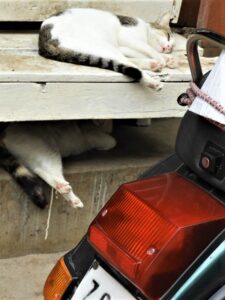 dawn, cruising slowly by, voices likely discussing the catch (good, or bad); is that what I saw in the pile just inside the fishy-smelling building? The market is (understandably) a paradise for cats; as I walked along I spotted cats everywhere; licking their paws, taking a snooze, their little sniffers dreaming sweet, sweet dreams.
dawn, cruising slowly by, voices likely discussing the catch (good, or bad); is that what I saw in the pile just inside the fishy-smelling building? The market is (understandably) a paradise for cats; as I walked along I spotted cats everywhere; licking their paws, taking a snooze, their little sniffers dreaming sweet, sweet dreams.
 I was headed for the Zanzibar Coffee House. Tour Guide Said worked it out with Ali, our driver, to get me as close as possible about the time he and Rick would arrive on the Walking Tour. The “closest” was a 10-minute walk for me (slowly, slowly, pole, pole) through the swirling noise and smells and color where everything was for sale but pig. Spice Island spices, yes. Octopus, changu (a favorite fish), chicken, piles of seafood; bananas, oranges, avocado, pineapple. Shoes. Electronics. What fascinated me most? We’d seen piles of produce and clothing and other tradeable items at markets all the way through Kenya and Tanzania, so crowds and color were not unusual to my eyes. Here though, everything was compressed; tucked into the narrowest of spaces, which seemed to magnify the scene. A dazzling mixture of Arab, Persian, Indian, European and African styles and traditions! Stone Town’s cast of characters is better than a Hollywood movie set. Action! Camera!
I was headed for the Zanzibar Coffee House. Tour Guide Said worked it out with Ali, our driver, to get me as close as possible about the time he and Rick would arrive on the Walking Tour. The “closest” was a 10-minute walk for me (slowly, slowly, pole, pole) through the swirling noise and smells and color where everything was for sale but pig. Spice Island spices, yes. Octopus, changu (a favorite fish), chicken, piles of seafood; bananas, oranges, avocado, pineapple. Shoes. Electronics. What fascinated me most? We’d seen piles of produce and clothing and other tradeable items at markets all the way through Kenya and Tanzania, so crowds and color were not unusual to my eyes. Here though, everything was compressed; tucked into the narrowest of spaces, which seemed to magnify the scene. A dazzling mixture of Arab, Persian, Indian, European and African styles and traditions! Stone Town’s cast of characters is better than a Hollywood movie set. Action! Camera!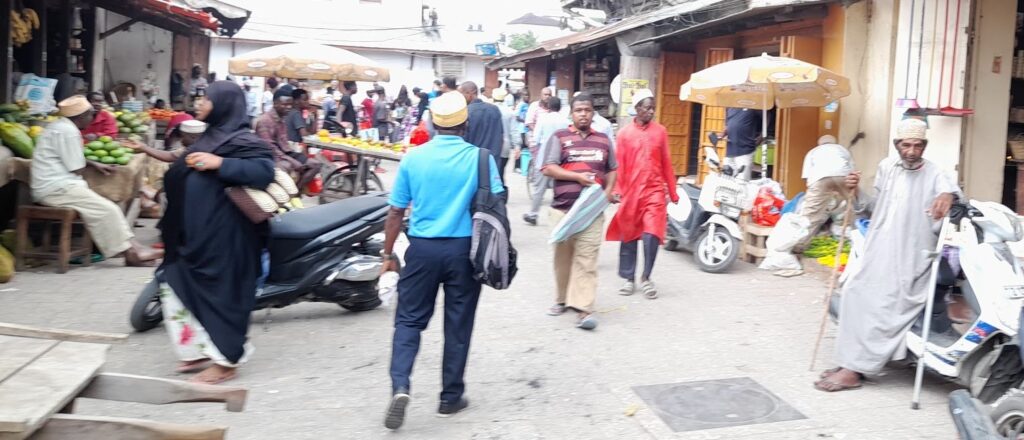
Some things to get a picture of: traditional buildings have a baraza, a long stone bench for resting or socializing along the outside walls; it’s an elevated sidewalk if it rains too much. Most buildings have large verandas (look up) protected by carved wooden balustrades. The  town is a maze of narrow alleys and most streets are too narrow for cars, so it’s crowded with bicycles and motorbikes. Darajani Market, which has been around since 1904, is on the edge of Stone Town, extending to the wider street along the seafront. Another interesting market – actually a giant open-air restaurant
town is a maze of narrow alleys and most streets are too narrow for cars, so it’s crowded with bicycles and motorbikes. Darajani Market, which has been around since 1904, is on the edge of Stone Town, extending to the wider street along the seafront. Another interesting market – actually a giant open-air restaurant 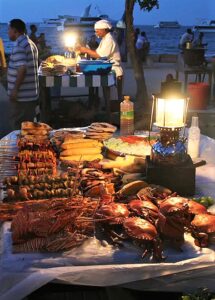 – is in Forodhani Park, right on the waterfront. Every night food stalls set up there to serve every kind of seafood you can imagine; people come in droves (locals and tourists alike); hey, Anthony Bourdain did a feature on it; he had octopus! Did I get my Zanzibarian coffee today? I did indeed, in an authentic Arabic house constructed in 1885 by Sir Tharia Topan, Wazir to Sultan Said Barghash. A wazir is an aide, or minister, by the way. More on sultans coming up.
– is in Forodhani Park, right on the waterfront. Every night food stalls set up there to serve every kind of seafood you can imagine; people come in droves (locals and tourists alike); hey, Anthony Bourdain did a feature on it; he had octopus! Did I get my Zanzibarian coffee today? I did indeed, in an authentic Arabic house constructed in 1885 by Sir Tharia Topan, Wazir to Sultan Said Barghash. A wazir is an aide, or minister, by the way. More on sultans coming up.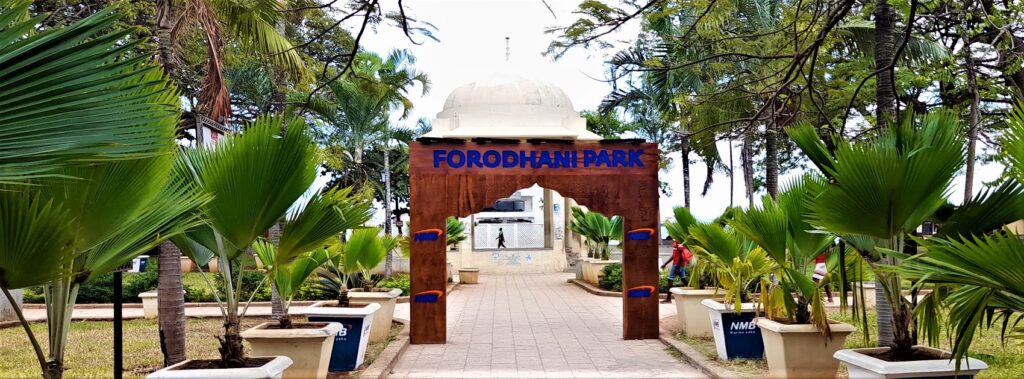
Can you find our guide Said? He’s wearing the gold hat (kufi) and the blue shirt.
“To Market, To Market” is a folk nursery rhyme based upon the traditional rural activity of going to a market where agricultural products would be bought and sold. Typically chanted when bouncing baby on your knee, it came to mind while I was walking “the market” today.
- To market, to market, to buy a fat pig,
- Home again, home again, jiggety-jig.
- To market, to market, to buy a fat hog,
- Home again, home again, jiggety-jog.
- To market, to market to buy a plum cake,
- Home again, home again, market is late.
- To market, to market, to buy a plum bun,
- Home again, home again, market is done.
Zanzibar Serena Hotel https://www.serenahotels.com/zanzibar
Zanzibar Coffee House https://www.utengule.com/zanzibar-coffee-house
Fisherman’s Tours https://fishermantours.com/
Next Post: Sultans and Slavers
» posted on Monday, September 26th, 2022 by Linda Lou Burton
Freddie & The Doors
Linda Lou Burton posting from Zanzibar Serena Hotel, Stone Town, Zanzibar, Tanzania –  Is this going to be a post about rock stars? Well yes, and no. Those of a certain generation might think “rock stars” when you see The Doors; likewise when you see the name Freddie. Freddie Mercury. Queen. The Doors. They were the noise of the 60s, and onward; controversial and influential, changing music and leaving behind songs that stick with us to this day. And they were flamboyant! So it was a bit of a surprise to realize our hotel was just around the corner from the Freddie Mercury museum in Stone Town, Zanzibar, a city steeped in traditions that go back to Medieval times. Freddie didn’t BECOME a rock star in this setting, but he was BORN in Stone Town on September 5, 1946, as Farrokh Bulsara to
Is this going to be a post about rock stars? Well yes, and no. Those of a certain generation might think “rock stars” when you see The Doors; likewise when you see the name Freddie. Freddie Mercury. Queen. The Doors. They were the noise of the 60s, and onward; controversial and influential, changing music and leaving behind songs that stick with us to this day. And they were flamboyant! So it was a bit of a surprise to realize our hotel was just around the corner from the Freddie Mercury museum in Stone Town, Zanzibar, a city steeped in traditions that go back to Medieval times. Freddie didn’t BECOME a rock star in this setting, but he was BORN in Stone Town on September 5, 1946, as Farrokh Bulsara to  Indian-born parents Bomi and Jer Bulsara. Bomi was a cashier at the British Colonial Office in Stone Town; Zanzibar was a British Protectorate at the time. Farrokh spent most of his school years in India, coming back to Zanzibar in 1963 to be with his parents; but in spring of 1964 the family fled to England to escape the violence of the revolution against the Sultan of Zanzibar and the mainly Arab government. Farrokh changed his name to Freddie Mercury in England and you know the rest of that story. (Or not.) The Museum was opened in Zanzibar November 24, 2019, commemorating the 28th anniversary of Freddie’s death.
Indian-born parents Bomi and Jer Bulsara. Bomi was a cashier at the British Colonial Office in Stone Town; Zanzibar was a British Protectorate at the time. Farrokh spent most of his school years in India, coming back to Zanzibar in 1963 to be with his parents; but in spring of 1964 the family fled to England to escape the violence of the revolution against the Sultan of Zanzibar and the mainly Arab government. Farrokh changed his name to Freddie Mercury in England and you know the rest of that story. (Or not.) The Museum was opened in Zanzibar November 24, 2019, commemorating the 28th anniversary of Freddie’s death.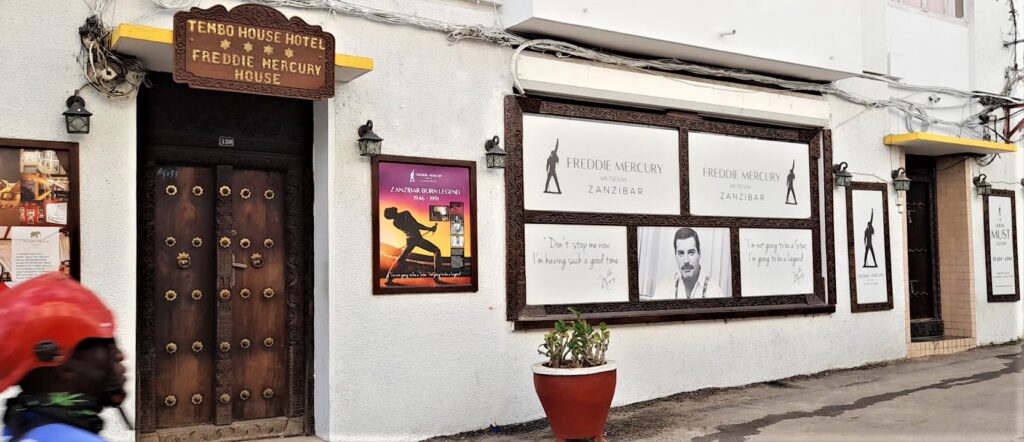
“We can walk there together later on our own,” we agreed this morning as Rick headed out to begin his organized City Walking Tour. Well, we didn’t. But Rick walked past it on his tour, and I rode past it in the tour van later. Ha! At least we both saw the beautiful DOOR out front.
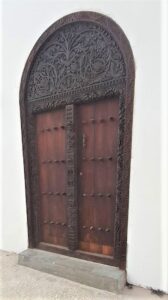 NOW TO THE DOORS: Zanzibar is FAMOUS for its DOORS! As it should be; they are elegant, intricate, beautiful, and long-lasting bits of “history we like to look at.” Fortunately, craftsmen and artists and entrepreneurs will make one for you in this day and time, for a price of course. Rick and I were just intent on looking AT them today, and thinking about events that took place on either side of them. What stories they could tell! The buildings in Stone Town are old; the streets and alleyways are narrow and crowded. We both took photos; of doors surrounded by people, cats, cars, life in a hurry or life over a cup of coffee. I give you a few descriptive bits (don’t get bored) about the meaning of the designs, see what you can pick out on the photos of the doors we saw. How old would you guess each door to be? Consider this:
NOW TO THE DOORS: Zanzibar is FAMOUS for its DOORS! As it should be; they are elegant, intricate, beautiful, and long-lasting bits of “history we like to look at.” Fortunately, craftsmen and artists and entrepreneurs will make one for you in this day and time, for a price of course. Rick and I were just intent on looking AT them today, and thinking about events that took place on either side of them. What stories they could tell! The buildings in Stone Town are old; the streets and alleyways are narrow and crowded. We both took photos; of doors surrounded by people, cats, cars, life in a hurry or life over a cup of coffee. I give you a few descriptive bits (don’t get bored) about the meaning of the designs, see what you can pick out on the photos of the doors we saw. How old would you guess each door to be? Consider this:
- The Swahili or Zanzibari doors were developed during the Middle Ages.
- The oldest are found along the East African coast from Mozambique to Kenya.
- The highest concentration of remaining doors is in Zanzibar’s Stone Town.
- They were created for the wealthy: sultans and slave traders and caravan traders.
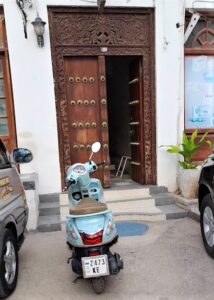 The Swahili designs are divided into two types; the classic rectangular is more geometric with more pre-Islamic forms; with motifs of lotus, rosettes, chain, date palms, and fish. Later designs changed to arched lintels; these doors have more floral patterns due to Indian inspiration as more Indian immigrants came to East Africa. The chain was replaced with beads on the frame; the fish became a vase with vines. The center of the lintel in both the rectangular and arched style usually has an Arabic inscription – a quote from the Koran, the date of completion of the door, or the owner’s initial and/or name. The doors themselves are not carved, instead, they are studded with metal tiers usually made of Brass or cast iron. The wood used for the most expensive doors is African ebony or imported teak.
The Swahili designs are divided into two types; the classic rectangular is more geometric with more pre-Islamic forms; with motifs of lotus, rosettes, chain, date palms, and fish. Later designs changed to arched lintels; these doors have more floral patterns due to Indian inspiration as more Indian immigrants came to East Africa. The chain was replaced with beads on the frame; the fish became a vase with vines. The center of the lintel in both the rectangular and arched style usually has an Arabic inscription – a quote from the Koran, the date of completion of the door, or the owner’s initial and/or name. The doors themselves are not carved, instead, they are studded with metal tiers usually made of Brass or cast iron. The wood used for the most expensive doors is African ebony or imported teak.
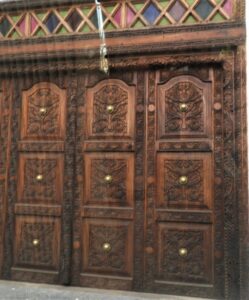
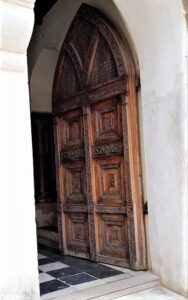
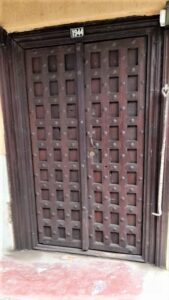

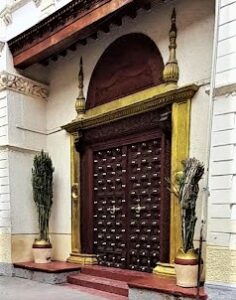
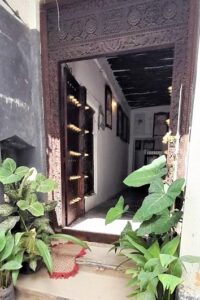
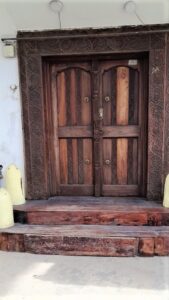
Zanzibar Serena Hotel https://www.serenahotels.com/zanzibar
Fisherman’s Tours https://fishermantours.com/
Freddie Mercury Museum https://freddiemercurymuseum.com/
Next Post: To Market, To Market





